The post Kerala’s Marcian Politics of Violence – Some Unforgettable Facts appeared first on Dharma Today.
]]>And this article is an attempt to expose the orgy of unprovoked violence and merciless killings indulged by the CPI (M) in Kerala Participating in the discussions on the subject in the state Assembly on September 26, 2016, the Chief Minister said that peace could not be restored in the state by convening an all-party meeting, and the only way out was to reign in the organisations in Kerala, imparting training to commit murders. If Pinarayi Vijayan were at all honest, he should have taken stringent action against the cadres of his own party, who have virtually turned bomb-making into a cottage industry, and move about on two-wheelers and four-wheelers carrying daggers and swords to locate and finish off their political adversaries. And the moment they lay down their daggers, swords and bombs, in no time Kerala will turn once again into a heaven of peace and tranquillity.
To borrow the words of CPI (M) veteran and nonagenarian, V.S. Achutanandan, anybody in the habit of taking ‘rice-food’ can very well guess against whom Pinarayi Vijayan was pointing his finger. Reacting to an incident in which a BJP activist was murdered in broad daylight in his own village Pinarayi, the chief minister had no qualms to claim that the RSS was spreading falsehood after killing the person themselves. If what he said was true, he should have taken necessary measures to substantiate what he said, by producing solid evidence against the RSS. If at all Pinarayi Vijayan is honest, he, as the chief minister, has to order an impartial enquiry into the political murders committed in the state so far, or, at least, after he took over as the chief minister of the state. The people of the state are interested to know as to why political murders take place regularly in a state being ruled by a Leftist alliance headed by the CPI (M), whereas thirteen or more states ruled by the BJP are free from this menace? Why no action is being taken in the wake of so many murders, especially when the chief minister himself is handling the Home Portfolio? The fact of the matter is Pinarayi Vijayan refuses to budge even by fraction of a millimetre from the mindset of the leader of the goonda-gang of the party to that of the state chief minister!
Who imparts training to kill?
Anyone who looks into the history of the unending stream of political murders taking place in Kerala will easily be able to find as to who is imparting training in and abetting murders in the state. The comrades, who are nostalgic about Kayyoor and Karivelloor, also take pride in the hacking of a hapless policeman to death at Morazha, during the pre-independence days. It was only recently the media had brought to light the details of a conspiracy hatched by the Marxists to kill Kelappaji, a renowned Gandhian and a great man and social worker in his own right. Let the chief minister, who was one of the accused in the murder of Vadikkal Ramakrishnan, a poor tailoring worker, in 1969, reveal as to which organisation gave training to him and his accomplices? Who had given training and encouragement to those who had killed Sreedharan Nair, a RSS-BJS worker of Ponkunnam in the same year, and Veliyathunadu Chandran, the Aluva district physical training instructor of the RSS, in 1970? In 1978, who imparted necessary training to mercilessly kill Panunda Chandran, a student and the son of one of their own party worker, the curtain-raiser incident that set in motion the orgy of endless political violence and senseless murders in the Kannur district? Violence and murders are very much in the blood of the Communist Movement. To be precise, these are in the movement’s very DNA.
The horrifying figure of the human-slaughter that was carried out in Soviet Russia, the epicentre of international Communism, has come before the world breaking through the “Iron Curtain.” Also, the world is privy to the well-planned and cruel plot designed by Stalin and his cohorts to assassinate Trotsky, who was with them when they usurped power in Russia. The world has also witnessed the way thousands of students were mercilessly crushed under rolling battle tanks at the Tiananmen Square in China, for demanding freedom of speech and action against the corrupt administration.

Stalin’s extermination theory, “Intense hatred is the basis of our success,” is the motivating force for the Communists all over the world. Former Member of Parliament from Kannur, M.P. Abdullakutty, who was also one the leader of the students’ wing of the CPI (M), in his biographical book, ‘Ningalenne Congress aakki,’ (You turned me into a Congressman) has recalled an incident, in which, during an informal chat, Pinarayi Vijayan narrated to him how the comrades in Bengal ‘handled’ their adversaries, without leaving behind even the remotest trace of any evidence. Through this narrative, Pinarayi Vijayan was, in effect, prodding his companions to kill others. This was, according to Abdullakutty, what Pinarayi Vijayan had said: “Once you catch the adversaries alive, bundle them in gunny-bags and lower the bundles in deep pits and cover the bundles with a thick layer of salt, before filling and levelling the pit with earth, there will not be any evidence whatsoever to prove their murder. Can you find any other political party or leader anywhere, who can suggest a better way to liquidate the enemies without leaving any trace of evidence!
Horrible nature of the Communist killings
The murders committed by the Communists will invariably have a common pattern: they will be extremely cruel, inhuman and barbarous. Also, such murders cannot be attributed to any sudden outburst of emotions caused by some untoward incidents, but have been committed with premeditation, immaculate planning, identifying the prey well in advance. Moreover, all murders committed so far have been well-planned and executed through hired killers, giving them money and arms, apart from arranging hiding places for them after the operation. The gory nature of murders and the number of cuts inflicted on the victim forms the yardstick to assess the excellence of the murder. Killing teachers in front of their students; hacking children to death in front of their mothers; murdering parents in front of their hapless children; killing the husband by cutting him into pieces in front of his wife; burying the victim’s body in mire; in the event of failure to force entry into the victim’s home, setting fire to the house using inflammable material to ensure the death of all inmates; If someone tries to escape from their murderous attack by jumping into some river, stoning him to death to ensure a watery grave for him. These are some of the devilish ways how they kill their victims.
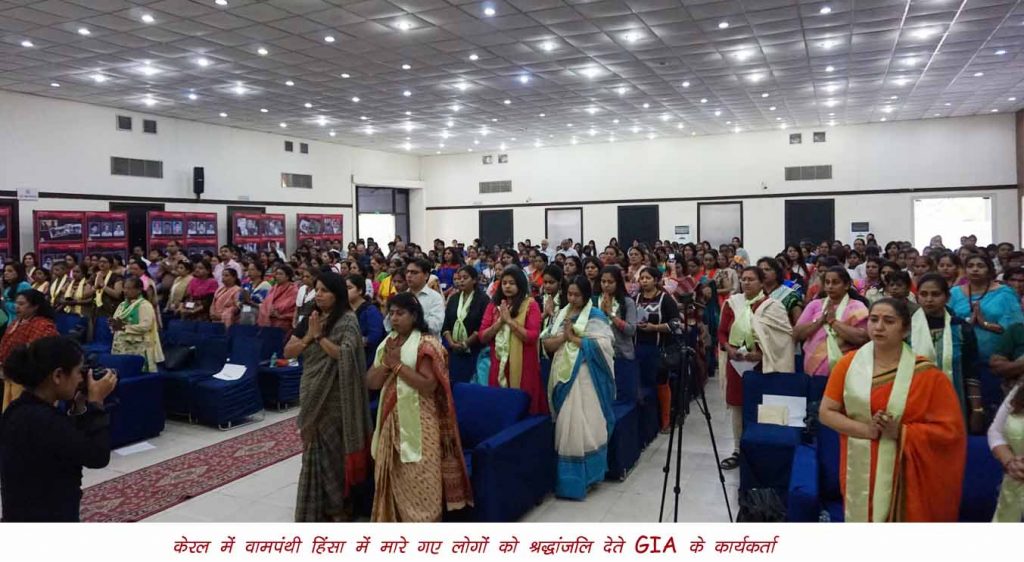
Even the other forms of violent operations the CPI (M) goonda-gangs indulge in have been most cruel and sadistic. The common nature and modus operandi of such violent ‘missions’ carried out all over the state is proof enough of the training the party has been giving to its goonda-gangs to conduct such criminal activities. First of all, they create an atmosphere of horror by exploding improvised explosive devises at the place of action; then, catching hold of their prey, they break their legs and hands in such a fashion to render them cripples for the rest of their lifetime. If they chop off the hand, they violently scratch the severed part against some hard surface and fling it away so as to ensure against its reattachment at any hospital, even in case of its retrieval; they use nail-driven wooden strips to beat their prey with so as to inflict deep and serious wounds on them; they set fire to vehicles and even throw two-wheelers into the wells; they demolish houses and cause extensive damage to television sets, telephone instruments, refrigerators, wooden-cabinets, etc.; they make a bonfire of mattresses, dresses and ransack and defile prayer rooms; they pollute wells by pouring in black oil or depositing hair-waste brought from hairdressing saloons; they even injure cattle and destroy coconut and areca- nut trees; they inflict grievous injuries on even tiny tots; if they don’t find men in whose search they have come, they don’t mind kicking wailing women of the household to vent their wrath and also use abusive language against them; And Kerala has seen them expressing their ‘love for humanity’ umpteen times through such reprehensible acts. In short, their only sadistic intention is to ensure a miserable and pathetic life to their perceived enemies, even if, by chance, peace and tranquillity returns.
Anti-law, anti-democratic
The CPI (M) never allows activities of other organisations at places which they claim as their strongholds. Neither do they allow hoisting of any other flags than their own flag at such places. It is such an anti-democratic and intolerant attitude of the party that leads to violence. Also, CPI (M) never acknowledges the right of the other parties to propagate their ideology. There have been many instances in which the CPI (M) had either threatened or abducted candidates belonging to other political parties, who had filed nomination papers to contest election against their candidates, to ensure that their candidates won the election unopposed. And the dubious practice of casting the votes of people who are either dead or out of station, by the CPI (M) in polling booths at their strongholds is highly surprising.
During the Assembly Elections in 1980, hundreds of Congress Party workers, who were physically- assaulted by the CPI (M) goondas for their ‘fault’ of acting as the polling booth agents of the Congress Party in the CPI (M) strongholds had to be admitted to the District Hospital in Kannur. During election time, there were also instances in which the BJP’s announcement vehicles were intercepted by the CPI (M) and misused such vehicles for their announcement. During the latest Assembly Elections, at Pappinissery, one of the strongholds of the CPI (M), a booth agent of the BJP was threatened by placing a dagger on his throat and he was also forced to give in writing, “Hereafter I shall do no political work.” And the visuals of this incident were telecast by all visual media in Kerala. Even in Pinarayi Vijayan’s own constituency, Dharmadom, it is surprising that the instances of fake voting were galore.
As a matter of fact, there is hardly any political party in Kerala, which has not been the prey of the CPI (M) violence. Apart from the Indian National Congress and the Indian Union Muslim League, even the CPI (M)’s alliance partner and parent organisation, the CPI, and the party’s alliance partner at the national level, the RSP, also has had the taste of their violence. Their approach to late M.V. Raghavan, who had played an important role in strengthening the CPI (M) in Kerala, after he was expelled from the party, was awful, and he survived only because of his sheer luck. When all attempts made by them to kill him proved futile, out of frustration, they vented their ire against the dumb snakes and birds at the Snake Park, run by him at Pappinissery. They had mercilessly killed many a CPI activist, who had quit the Left alliance. After the split in the Communist Party of India in 1964, the two factions were known as the Left Communist Party and the Right Communist Party, and the way the Left Communist Party dealt with a toddy-tapper of Alapuzha, who belonged to the Right Communist Party, was something horrendous. Not satisfied with breaking his right leg and right hand they as well wrenched his right earlobe and gouged his right eye in a gory fashion!
The slogan raised by the activists of the women’s wing of the party against C. Achutha Menon, a perfect gentleman and a highly respected political leader, was this: “Who is Achutha Menon’s father? Shame! Shame! You ignoble creature, keep the red flag down!” So, how can one except decency from a political outfit that trains its followers to behave in such an obnoxious manner?
CPI (M)’s response to peace initiatives
Not only that the CPI (M) has never made any honest positive move to create an atmosphere of peace and tranquillity in the state, all along it has pursued a policy of abetting, encouraging and providing every assistance to the party cadres to freely indulge in violence. The shameful inactivity of the CPI (M) and the valiant resistance put up by the RSS workers during the Emergency, gave an opportunity to the people of Kerala to evaluate both the organisations. As a result, youths and students were attracted to the RSS in a big way. During the final days of the Emergency, the RSS workers as a whole came out on the field to fight against totalitarianism. As the elections was fought by the Janata Party, in which the Bharatiya Jana Sangh had merged, in alliance with the CPI (M), in spite of serious ideological differences, the RSS workers wholeheartedly came forward to work in the constituencies in which the CPI (M) candidates were fighting. Even in the constituency of Pinarayi Vijayan, who was one of the accused in the murder case of Vadikkal Ramakrishnan, one of their co-workers, in deference to the wishes of their organisation, the RSS workers had actively participated in the campaign. However, because of the mindset of the people of the state, which was against the violent nature of the CPI (M), they were routed in the elections in Kerala, whereas all over Bharat the forces of democracy made a big gain. The people of Kerala opted for the totalitarian Congress party.
Anyhow, the ever gaining popularity of the RSS made the CPI (M) jittery. So, their leadership started a campaign under the banner of “anti-communalism.” But, more than a campaign against communalism, it was in effect, a campaign to call upon the people to beat to death the RSS men as they kill rabid dogs. And the unprovoked murder of Panunda Chandran in Kannur and a series of killings and violence thereafter, were a consequence of this.
First, it was Dattopant Thengadi, a senior RSS pracharak and the founder of the Bharatiya Mazdoor Sangh, and Comrade Ramamoorthy, the CPI (M) leader, who facilitated a meeting between the state leaders of the RSS and the CPI (M), at Ernakulam, as part of the peace initiative. Then, P.Parameshwaran, Director, Bharatiya Vichara Kendram, Thiruvananthapuram, took the initiative to arrange a meeting of two senior RSS pracharaks of Kerala, Bhaskar Rao Kalambi and R. Hari, with the then Kerala Chief Minister, E.K. Nayanar, in New Delhi. And finally, Justice V.R. Krishna Iyer took the initiative to restore peace by facilitating talks between the two sides. And every time, it was the state leadership of the CPI (M) that thwarted the attempts to restore peace in the state, as they were never interested in restoring peace. At one time, the Marxist ideologue, E.M.S. Namboodiripad, had even declared, “We will take up arms against the RSS.” When a question about an incident in which three ABVP workers were stoned to death by the CPI (M) goondas in the Pamba River in Perumala, was raised in the state Assembly during the chief minister-ship of E.K. Nayanar, the response of the chief minister was, “Why, were they not ABVP workers, what have you to do with it?” Nayanar’s reply implied that it was their privilege to kill the ABVP and Sangh Pariwar workers and no one else had any right to question it! During the high tide of CPI (M) violence, in Kannur, the unearthing of a large number of crude bombs from the residence of a party activist, situated in one of their strongholds, by a police party led by an impartial police officer, sent a shockwave throughout the state. But, when the media people enquired of the chief minister, Nayanar, about the incident, he nonchalantly replied that those were firecrackers intended for the Vishu festival. It is amply clear that the senseless violence unleashed by the CPI (M) cadres ever since Pinarayi Vijayan became the Kerala chief minister, and the provocative comment, “The wages for the work in the field will be paid at the ridge,” made by the present state secretary of the party, Kodiyeri Balakrishnan, are definitely intended to encourage the cadres to take to violence.
The training given in the RSS Sakhas is aimed at fostering discipline, patriotism, unity and mutual love. Quoting the extermination theory of the Russian autocrat Joseph Stalin, who said, “Intense hatred in the basis of the success of the Communist parties,” Sri Guruji Golwalkar, the second Sarsanghchalak of the RSS, once said: “Sacred love is the basis of our success.”
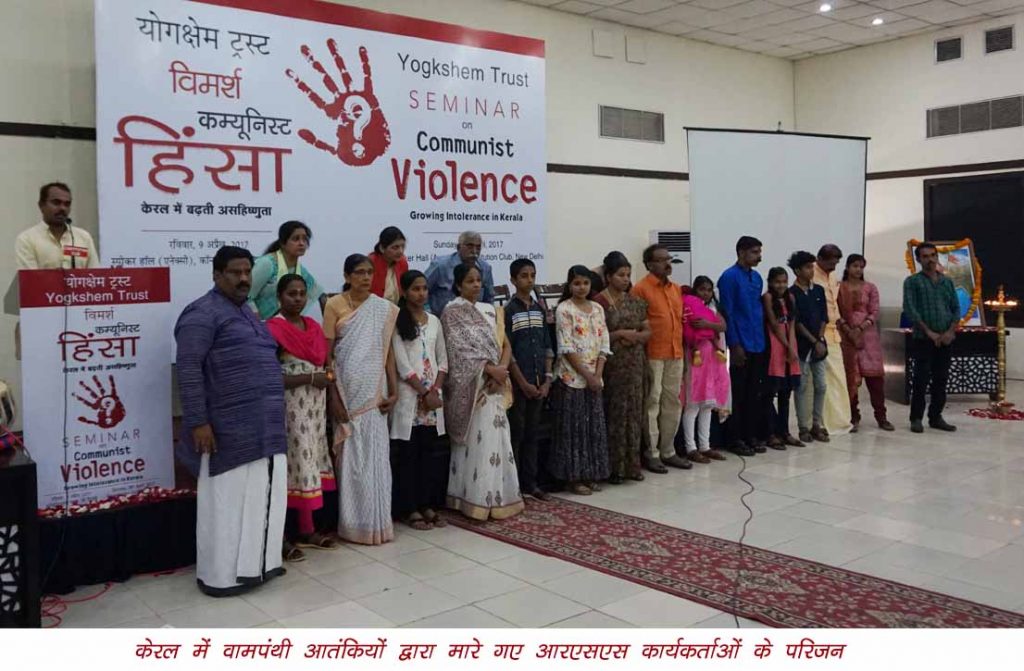
In 1979, when the murder politics of the CPI (M) was at its zenith, the then Sarsanghchalak, Poojaniya Balasahab Deoras, had visited Thalassery. On that occasion, his address to thousands of people, including a large number of uniformed Swayamsevaks, was never aimed whipping up passions. He said: “The RSS welcomes ideological debate and the Marxists, giving up their arms, should come forward for a fight at the ideological level.” After winning the fight against the Emergency, challenging cruel form torture and even death, Deorasji had undertaken a tour of whole Bharat. During that tour, as a committed and responsible leader, the call he gave to the Swayamsevaks was to forget and forgive all atrocities they were subjected to. Also, he exhorted them to actively participate in the nation-building activity. In the1980s, late P. Madhavaji, who was one of the RSS ideologues in Kerala, had undertaken an extensive tour of the Kannur district. In an atmosphere in which the Swayamsevaks were eager and impatient to defend themselves and also for retribution, in the wake of killing of Swayamsevaks, torching of their houses by the CPI (M) cadres, and putting them behind bars, implicating them in false cases by pliable police officers at the instance of the party-men, what Madhavji said, while addressing the Swayamsevaks, was this: “Our fight is against Communism and not Communists. By killing one or two Communists, Communism cannot be eradicated. Our fight should be to defeat it both at the theoretical and organisational level. Presently, Communists are treading a wrong path. But they are our own brethren, who, after realising their mistake, are sure to join us, if not today, tomorrow.” Although Madhavaji’s counsel was not acceptable to the Swayamsevaks of Kannur who were emotionally surcharged and were in a mood for some counter-action, they, nevertheless, accepted his advice against falling a prey to their emotions and to act wisely. During those days, the media, as if to add fuel to fire, used to compare the murders with scoring goals in a football match. And Madhavaji’s counsel had come at a time when the mental complexion was such that it was thought that the failure to win the match by scoring more goals would bring ignominy! As a result of the Sangh’s decision to follow the path suggested by Madhavaji, many CPI (M) cadres left the party and became Sangh workers. And, as a sequence, when the ‘party villages’ became ‘Sangh villages,’ the people there could taste the joy of peace and cooperation.
The post Kerala’s Marcian Politics of Violence – Some Unforgettable Facts appeared first on Dharma Today.
]]>The post Self Determination appeared first on Dharma Today.
]]>But that determination by which one holds fast to selfish results in religion, economic development and egoistic gratification is of the nature of passion.
– Bhagavad Gita (18.34)
Although human history reveals men and women of great character, these pages also contain names of people who teach us what not to do in life. Men with strong determination, yet misdirected ambitions, have wreaked havoc on civilizations.
One such case is the invader Babur, the founder of Mughal Empire in India.
At the age of eleven, Babur became the king of Fergana valley (in present day Uzbekistan) with his interests in poetry, art, music and gardening. Despite being a descendant of the dreadful Timur from his father’s side and the terrible Genghis Khan from his mother’s lineage, he chose to follow their footsteps, even if he wasn’t cut out for it. Both these conquerors had legendary, cult status in the medieval Muslim world for their brutality and wholesale massacres of civilian populations. It was then natural for Babur, a young impressionable boy at that time to nurture similar ambitions.
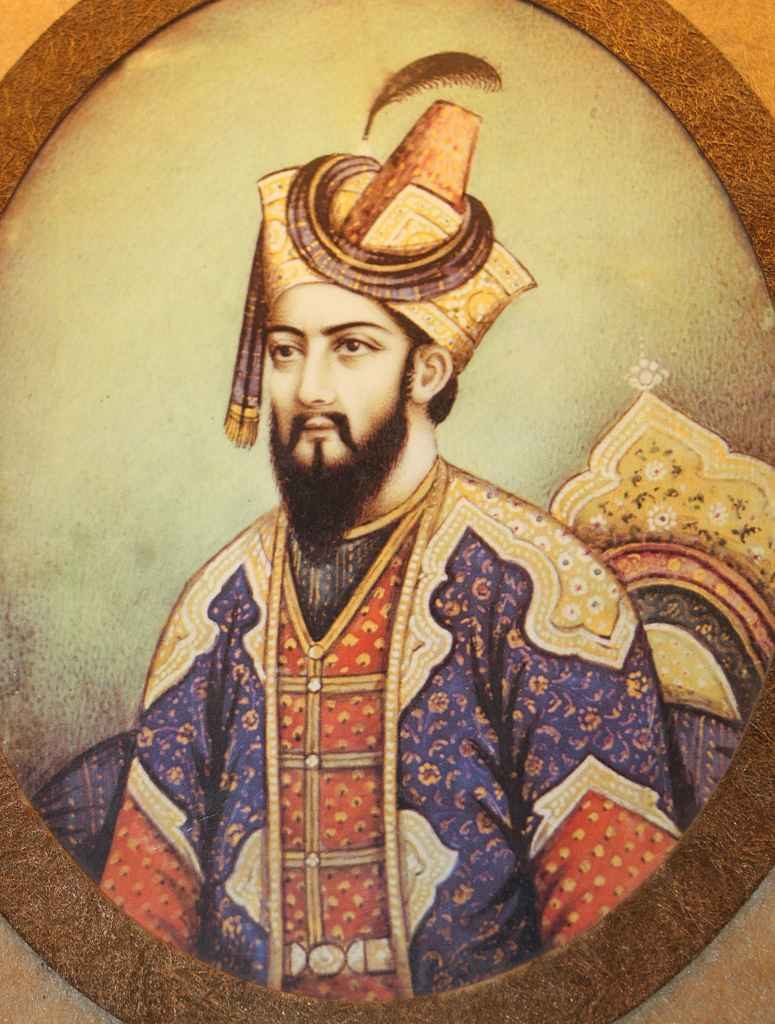 Desires swelled in his heart; he first sought to conquer Samarkand, a city in modern-day Uzbekistan, in honor of Timur who was born there. A young ambitious teenager, Babur began his march to seek power.
Desires swelled in his heart; he first sought to conquer Samarkand, a city in modern-day Uzbekistan, in honor of Timur who was born there. A young ambitious teenager, Babur began his march to seek power.
At the age of fifteen after a great struggle, Babur managed to gain control of Samarkand, but lost it in a few months. Meanwhile in his absence his brother usurped his native Fergana valley. Babur was thus left with no kingdom. He repeatedly tried to get Samarkand, and was obsessed, but faced constant failures. Finally, frustrated, he came back to retain Fergana, but even here he lost terribly.
He wandered in the mountains of Central Asia after escaping with a small band of followers and took shelter of tribes in these hilly regions. He endured poverty and humiliation and lost all hopes of regaining his country.
Babur writes in his memoirs that he had ascetic-spiritual tendencies, which was unnatural amongst his war mongering clan. And this was a good time for him to pursue his inner calling. Yet he chose to seek pederasty, a high fashion of the central Asian aristocrats of that time. He developed strong infatuation for a young sixteen year old boy and possessed several wives. In a life enveloped by bisexual relationships and ambitions to seek power, his asceticism and humanness was buried for good.
Slowly he focused on building a strong army and sought luck elsewhere. He captured Afghanistan but continued to abhor the vices and luxuries of Herat and Kabul; he found liquor and intoxicants disgusting.
Now Babur set his eyes on India. At that time the northern India was ruled by Ibrahim Lodi, and those who detested him, invited Babur to conquer Delhi. Here again, he faced failures. In 1524 when his army was routed by Lodi, Babur responded by burning the entire city of Lahore for two days, killing scores of innocent people and causing terrible destruction.
Two years later during the first battle of Panipat, Babur, equipped with artillery and cannons that were unknown to the Indian army then, defeated Lodi. Later he also defeated Rana Sangha of Mewar, again with his artillery that had no match, and Babur now became the undisputed Lord of Northern India.
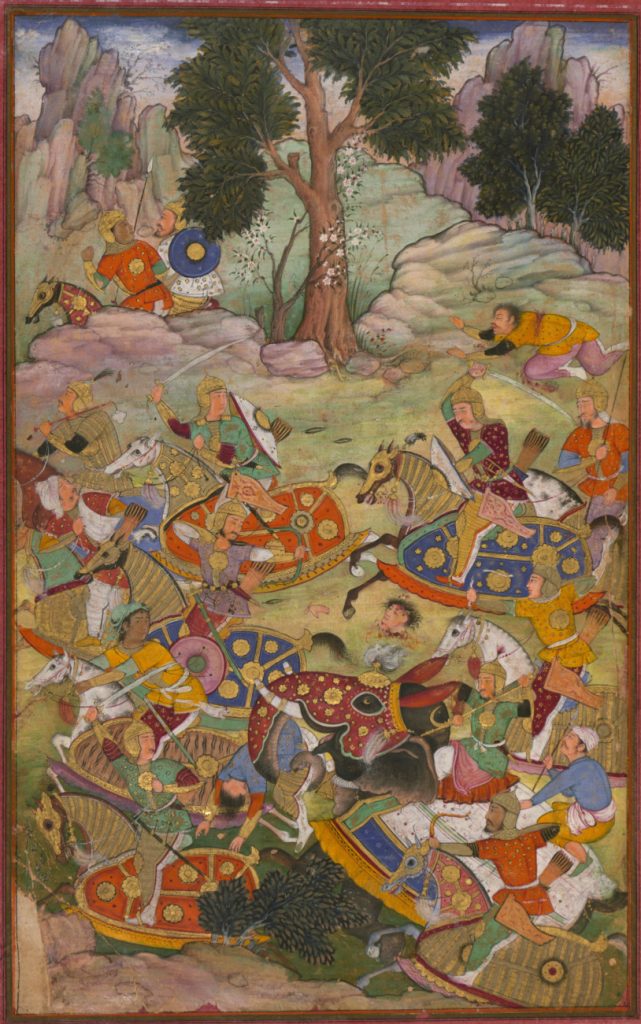
One would imagine he now had enough reasons to be happy. But ironically, now he began to drink, host wine parties and take opium and other narcotics. And he wasn’t happy. Historian Abraham Eraly reveals that even amidst this success in India he regretted that he couldn’t conquer Samarkand. His heart ached for what he failed to get elsewhere.
And is it difficult to know why he wasn’t happy? The Greek philosopher Epictetus answered it, “Happiness and personal fulfillment are the natural consequences of doing the right thing.”
While Babur prided himself as a holy warrior of Islam, during this period India saw the emergence of Guru Nank, the founder of Sikh religion who taught religious harmony. In stark contrast to Babur’s Jihad, India saw Vaishnavism branch of Hinduism take roots. And the Vaishnava saints taught the message of peace and love of God.
Babur developed excellent war strategies but wasn’t happy. He was at last doing things right, and that gave him victories, but was he doing the right things?
Babur had a chance to be a saint; he simply had to follow his calling. He could have been a messenger of peace and love, but he lost it. Babur could have, like the other saints, pursued his inner quest, yet he chose to be an agent of hate and violence. And what an irony, while he conquered India, he missed the Indian spirituality, and terribly lost his internal war. His ambition and determination led him to great external success, but at what cost? The most influential African American social reformer of the eighteenth century, Fredrick Douglas made a beautiful appeal to our conscience, “I prefer to be true to myself, even at the hazard of incurring the ridicule of others, rather than to be false, and to incur my own abhorrence”
We are constantly faced with distractions and temptations, and it’s not easy to follow our inner calling. Especially when the soft inner voice implores us to be an agent of positivity, but our raging mind and senses, impelled by the ego, direct us to do the wrong things. Paradoxical as it may sound, conscience is that still, small voice that is sometimes too loud for our comfort. Yet if we show courage and determination to follow the right but difficult path, we may be pleasantly surprised as we reach a beautiful destination. The right choices always give right results.
The truth is that you always know the right thing to do. The hard part is doing it. While Babur died long before he was buried, we could choose to live and love.
The post Self Determination appeared first on Dharma Today.
]]>The post Shades of Sex & The Radha-Krishna Love Affair appeared first on Dharma Today.
]]>However, love affairs have been a taboo in India chiefly due to their physical implications. Indians of all creeds and religions scorn physical love. What is astonishing about this phenomenon is that attitudes of ancient Indians, the Hindus, were very much different. Copious evidence can be still found in the old temples and palaces of India in addition to numerous literary sources. The expressions of Hindus reflect the holistic embrace of the physical self with the universal spirit, revealing a moral worldview that contrasts with the contemporary sensibilities of modern Indian society.
Sex and sensuousness are a major issue in everybody’s phenomenal life and are a constitutionally and rationally integral force of the organic self. But at times it is looked down upon as a purely radical material concern and therefore counter to a respectable and spiritual life. This attitude can be traced to the Abrahamic tradition, particularly the Christian bible, which downgrades sex in its naturality and holds the physical body as inherently (genetically) perverted and tainted. Thereby this view falsely implicates the assuagement of the physical body as undesirable for a meaningful and just life.
Could the physical aspects of love and sex not be a genuine part of the spiritual as a sattvic way of life? What defines intimacy? On the other hand we have a highly revered Radha-Krishna relationship that encompasses various degrees of intimacy. This article discusses the Vedantic viewpoint of the relationship between Radha and Krishna and questions the wisdom in downgrading sex.
Tradition And History of The Radha-Krishna Affair
The various dimensions of the complex Radha-Krishna love story pertinent to human life have been revealed to us through the ages by various Indian scholars and writers, ancient and modern, as well as scholars from all over the world. The Radha-Krishna love affair has been explained by many in the frameworks of the purusha-prakriti principle of the Sankhya-Yoga philosophy, of mystical bhakti (devotion), of the Tantric traditions and of purely materialist philosophy. However, in recent times, the unapologetic sensuous aspect of the divine love affair has relegated a sublime love story to the level of pornography, when its anything but that. It is also downgraded as a rule in view of the fact that the contemporary Indian sensibility prejudicially disdained physical love.
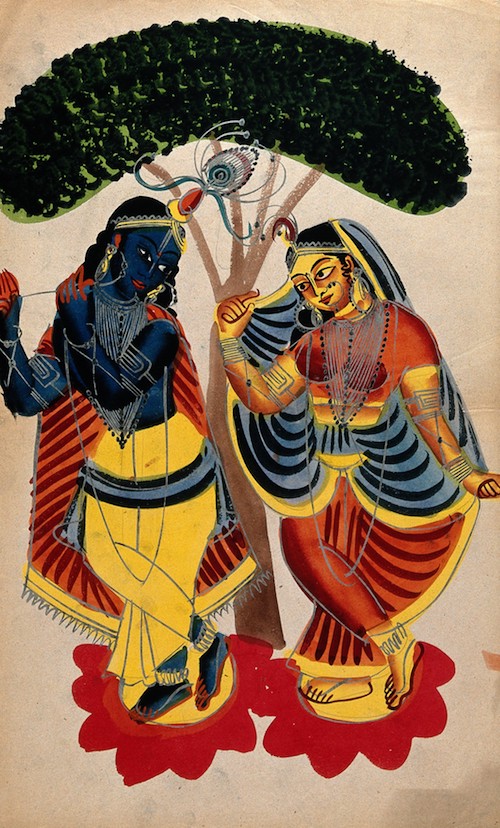
The earliest source of Krishna’s reputation as a great lover can be found in the Harivamsa Purana, which appeared as a supplement to the Mahabharata at least around 2000 years ago. Subsequently, Vishnu Purana and Bhagavata Purana, like Harivamsa Purana, also dwell on the avatar’s aspect as a sensuous lover.The role of the perfect lover adds up to Krishna’s multi-faceted personality, leading many Vedantic exponents to consider him as the complete Vishnu avatar. The Bhagavata Purana proclaims itself to be the greatest of all Puranas (Bhag. 12.13.16).
The Bhagavata mentions a certain nameless gopika who was favoured by Krishna for a time, while none of the other ancient literary sources mention Radha. This is one of the rare instances where a major deity in the Hindu tradition is not clearly mentioned. In Sanskrit literature, she appears for the first time in the inscriptions of the Paramara king, Vakpati Munja of Malwa (CE 973-94). However, the Radha-Krishna affair existed in the vernacular as folklore alongside Krishna’s other exploits and the roles he played for the upkeep of dharma.
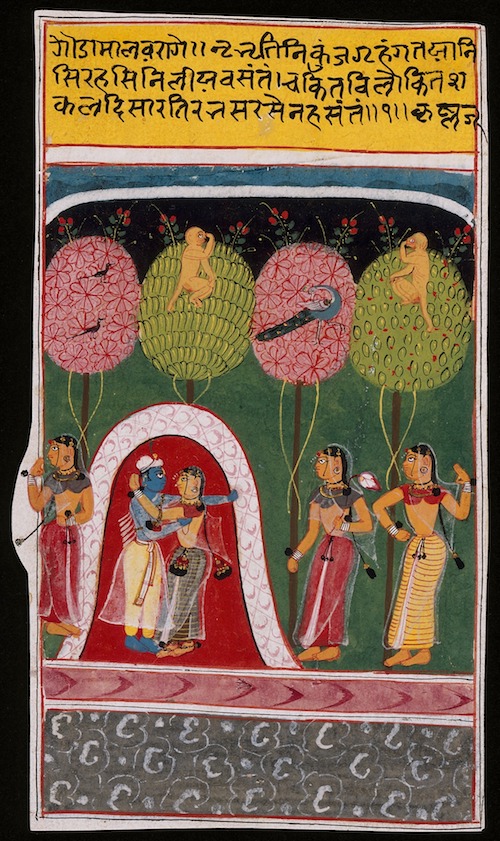
But this love affair did not make it to the classical level until Jayadeva composed Gitagovinda in the 12th century. Jayadeva broke away from past conventions and elevated Radha to a classical deity worthy of worship and described Her as an appropriate counter figure for Krishna in his role of the perfect lover, who emerges as the unquestioned central concern of His amours. Krishna was no longer a detached lover reciprocating the passion of gopis with equanimity. He suffered and agonized like Radha, in separation.
Krishna becomes complete as a lover only beside his consort, Radha. It could be argued that the Radha-Krishna affair shows very scant respect for middle-class morality and social inhibitions that define marital and familial ties. According to certain traditions, Radha was seven years older than Krishna and had fallen in love with him at first sight when he was a toddler, some claim the relationship to be illicit and so on. The apparent deviation from contemporary societal norms is a characteristic feature of the Radha-Krishna love affair that challenged conventional Hindu sentiments and continues to do so in the present times.
After Krishna left Vrindavan for Mathura, he continued to play his role as lover, fulfilling the desire of Kubja, a deformed and hunchbacked woman, eloping with Rukmini and making her his queen, then marrying more women in due course. However, the Radha-Krishna love affair is different from Krishna’s other love relationships in that one cannot miss the multidimensionality here. It is believed that Radha was Krishna’s first wife and was pointed out Bhandirvana in Vrindavan where Radha and Krishna had a Gandharva wedding in the presence of Lord Brahma himself. According to lore, in their last tryst before he leaves for Mathura, Krishna’s mesmerizing flute that erotically aroused all entities with its enchanting melody is bequeathed to Radha. He never played the flute again nor did he ever come back to Vrindavan.
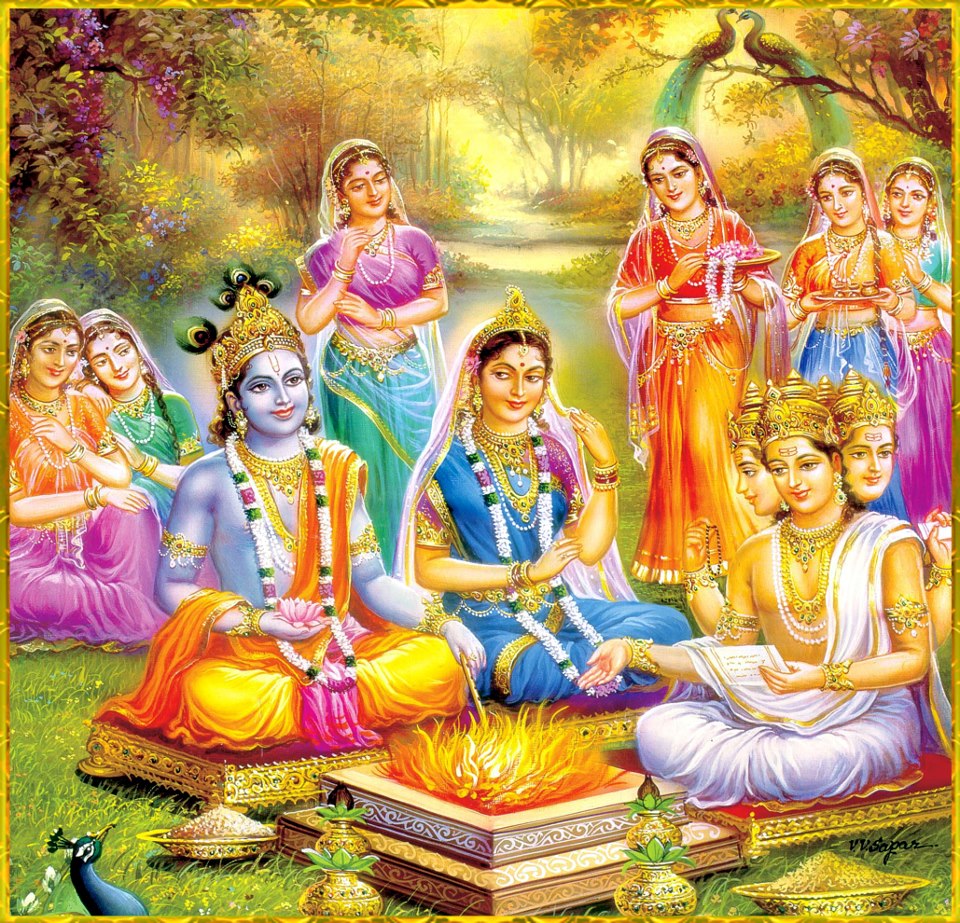 The centuries following Jayadeva were a tremendously creative period in sensuous love poetry narrating the Radha-Krishna affair; this time not in Sanskrit but in the languages of the common man, drawing on oral traditions. Chandidasa (Bengali), Vidyapati (Maithili), Surdas and Bihari (Braj) and Govindadasa (Brajaboli) presented the wide range of bold nuances in love play in the Radha-Krishna story and exhausted the whole spectrum of love covered by the divine couple.
The centuries following Jayadeva were a tremendously creative period in sensuous love poetry narrating the Radha-Krishna affair; this time not in Sanskrit but in the languages of the common man, drawing on oral traditions. Chandidasa (Bengali), Vidyapati (Maithili), Surdas and Bihari (Braj) and Govindadasa (Brajaboli) presented the wide range of bold nuances in love play in the Radha-Krishna story and exhausted the whole spectrum of love covered by the divine couple.
The Radha-Krishna tradition continued to inspire the people of India until Abrahamic sensibilities made inroads into the Hindu heartland through the missionaries and their colonial facilitators, both native and foreign. The success of the missionary campaign against the devadasi community was a mortal blow against this tradition. How lasting this turn of sensibilities was for the missionary-civilised Hindus can be discerned today by the overwhelming number of Hindus who are apologetic of the Radha-Krishna affair and who even try to bring up excuses for the sensuous story and explain away the love play as a metaphor for the mystical longing of the jivatma for the paramatma and so on and so forth. The statement is partially unfounded and displays the overwhelming degree of ignorance that has crept into modern Hindu society.
The Physical Body According to Vedanta
According to Vedanta, the knowledge of the self, the true reality, is the objective of human life that culminates in self-realization. This means self-realization is only pertinent to the human condition, of which the physical body is an indispensable element. The ‘Self’ is contextually used as the ‘Atman (Soul)’ the mind, intellect and body. The knowledge of Self begins from the physical body.
Besides being a reference point for existence, the physical body is an integral part of the material, phenomenal world composed of five elements, without which the knowledge of the self is impossible. It is the physical body that paves the way for self-realization. Vedantic metaphysics postulates that unrealized atmans go to pitruloka, where they enjoy their just deserts, but only to come back to earth as human beings pursuing the atman’s ultimate objective of self-realization. Self-realization takes place only on earth as humans, or to put it in another way, self-realization is applicable only at the level of human reality. Self-realization is neither valid nor applicable without a human body. The atman (self) takes a particular human body for carrying out its mission and is completely responsible for the body, in other words the deha (body) and the dehi (wearer or owner of the body). It is in this sense that the body is called a temple of the atman (self).
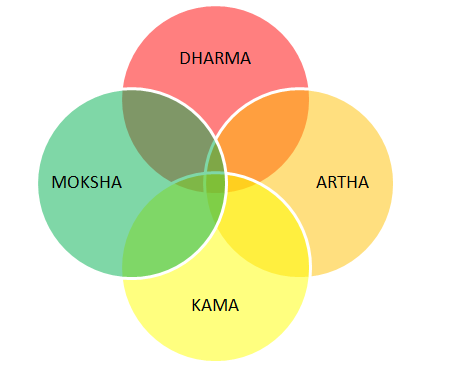 Spiritual life starts from the physical. According to Vedanta, one needs to finish with the matters of the body to advance to the next stage. One cannot aspire for self-realization without negotiating the body or independent of it. It is a futile effort to bypass the physical body to get to the spirit without coming to terms with it. Because body is a function of the mind, negation of the physical aspects of self cannot aspire to turn to Vedanta. This is the first step to ascend to the spiritual level. Generally, all Vedanta philosophical streams don’t make much of sex or physical love and some proponents even go to the extent of negating it. The reason is very simple – people turn to Vedanta only once they have negated sex and physical love. People who have physical desires need to address that first.
Spiritual life starts from the physical. According to Vedanta, one needs to finish with the matters of the body to advance to the next stage. One cannot aspire for self-realization without negotiating the body or independent of it. It is a futile effort to bypass the physical body to get to the spirit without coming to terms with it. Because body is a function of the mind, negation of the physical aspects of self cannot aspire to turn to Vedanta. This is the first step to ascend to the spiritual level. Generally, all Vedanta philosophical streams don’t make much of sex or physical love and some proponents even go to the extent of negating it. The reason is very simple – people turn to Vedanta only once they have negated sex and physical love. People who have physical desires need to address that first.
The purushartha or the four essential pursuits of human beings, as laid down by Hindu sages includes ‘kaama’ as a progressive journey. However it is the kaama that needs to be rejected for a spiritually progressive life. This seeming contradiction can be resolved easily because the latter version of kama is an aberration in the absence of dharma (adharma). The difference can be demonstrated by the example of consensual sex and rape.
Satisfaction of worldly desires in the ‘framework of dharma’ is a prerequisite for an atman before turning to moksha or self-realization. This pursuit is an episode in the life of every atman. However, the ‘purna’ (fullest/most expressed) avatar of Vishnu is beyond any man-made rule, as demonstrated by the Radha-Krishna love story. The temporal and therefore illusory social norms and inhibitions do not prevent the unravelling of the unique intimacy, clearly revealing these social interdictions to be utterly unsubstantial in the face of the everlasting values of life (Santana Dharma).
Shades of sex
Vedanta acknowledges that sexual desire is, at its core, longing for union with God [brahman]. Sex and physical love express themselves in a wide variety of ways. From the animals to the humans it can create havoc, if the urge is thwarted in its natural course. And when the unregulated or unnatural urges enter the human psyche, it sets the demonic emotions into motion. At the other end of this wide spectrum is the divine sex practised by Radha-Krishna. But both have their roots in the gross human body. In between this range, the several shades of physical love span out to cover a wide range of human emotions. An average consensual sexual relationship is said to teeter through all the three gunas or basic qualities of nature in a fluctuating wave.
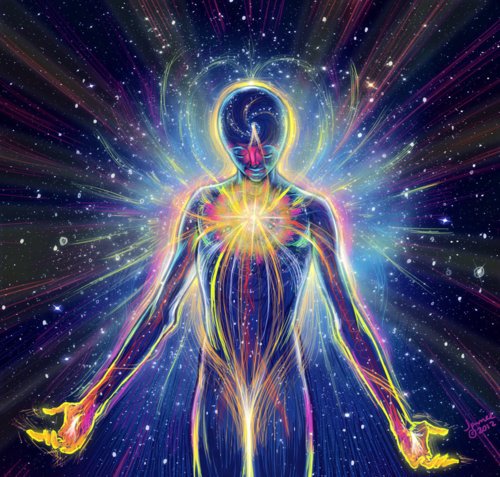 A student of Vedanta is required to rise above the three gunas equally, but for those who are still engrossed in the physical plane and have not yet turned to Vedanta, the sensible first step is to cultivate the sattvic tendency than to negate the physicality per se. And for the common people who are far away from Vedanta by inclination or custom, the correct course was inevitably drawn by the Dharma Sastras.
A student of Vedanta is required to rise above the three gunas equally, but for those who are still engrossed in the physical plane and have not yet turned to Vedanta, the sensible first step is to cultivate the sattvic tendency than to negate the physicality per se. And for the common people who are far away from Vedanta by inclination or custom, the correct course was inevitably drawn by the Dharma Sastras.
The Ultimate Sexual Union
This is corroborated by a late 16th century condensed version of the Bhagavata titled ‘Narayaniyam’ composed in Sanskrit by Melpathur Narayana Bhattatiri. The Bhagavata does not mention Radha, but by the time of Melpathur, she was already a revered figure. The 2nd sloka of the 63rd dasakam mentions that Krishna left the gopikas in the lurch and disappeared when he found that his association with them caused self-conceit in them. The 3rd sloka introduces Radha and also reveals why Krishna preferred her company.
In the exegesis (vyakhyanam) of this sloka, Professor R. Rama Varma Thampuran mentions that because of her egolessness, Radha was able to enjoy the bliss of union without the separation, whereas the other gopikas were deprived of Krishna’s presence because of their pride in their worldly self. The ultimate union of the atman and paramatman is achieved by losing the ego or the lower self that is attached to the body. This aspect introduced the adage “ek atman do sharir” (one atman two bodies) pertinent to Radha and Krishna.
Later, the unexpected farewell in Vrindavan that separated Radha from Krishna with much heartbreak is complemented by their meeting years later in Samanta Panchakam, the five water bodies that make up the Tirta in the Sarasvati drainage basin, in Kurukshetra. It predated Kuru and was a popular place of yajna for devas and renowned as the Brahmapura of the humans. Narayaniyam 84th dasakam describes Krishna’s journey to Samanta Panchakam during a solar eclipse with his entourage, all the Yadava men and women beside his wives, the Pandava princes and Draupadi. There they also meet Nanda and the gopis and gopikas including Radha.
 The ultimate union of the divine lovers takes place there. Krishna first makes peace with the gopikas, removing their pangs of separation by holding each of them to his bosom. The gopikas get instant liberation by experiencing the final union with their beloved. Then Krishna approaches Radha. He expresses his passion and puts forth excuses for his absence blaming it on the battles that had taken a toll on his time. Radha’s sorrow of separation and the bitterness she harboured in her heart is entirely assuaged by his embrace and they become one with each other.
The ultimate union of the divine lovers takes place there. Krishna first makes peace with the gopikas, removing their pangs of separation by holding each of them to his bosom. The gopikas get instant liberation by experiencing the final union with their beloved. Then Krishna approaches Radha. He expresses his passion and puts forth excuses for his absence blaming it on the battles that had taken a toll on his time. Radha’s sorrow of separation and the bitterness she harboured in her heart is entirely assuaged by his embrace and they become one with each other.
In the linear timeframe the affair with Radha is a closed episode in Krishna’s life, but at the same time it becomes a recurrent, earthly moment framed in eternity. Krishna’s flute still beckons human souls and all creatures that are born, live and die on earth. Whether we like it or not we are subject to the unique, earthly magic of love in all its sensuous variations, with its sweet joy of union and its pangs of separation. Sri Krishna and Srimati Radha, his worthy counterpart, teach us a basic lesson in earthly life: we can deny physical love but never the need for intimacy of which physical is but a part!
Transformation of Attitudes
Downgrading the sexual aspect of human life has two-fold disadvantages. One, people are denied one of the pursuits in the purusharta, the natural link of progression from the physical to the spiritual. Two, it denies physical love to those who need it. This deficiency also entails physiological and thereby psychological ill health. The suppression of natural sexual expression inevitably leads to decay and destruction of culture and ultimately of the species.
It is well known how the ‘Abrahamic type of monotheism’ destroyed the goddess worship and how its forceful dissemination of aberrant sensibilities destroyed the naturally evolved nature-worshipping religions, commonly termed paganism, and imposed a worldview insulated from natural phenomena. The alarming rates of sex crimes in India today are a direct result of the rise of the Abrahamic sensibility all over in the last millennia and the alienation of Indians from their natural moorings. Transgressions on women are unashamedly attributed to the woman and not to the man, and this injustice can be directly ascribed to the waning awareness of the divine feminine in human consciousness.
 Without Radha, Krishna is not the perfect lover. This is probably why he is considered the complete avatar, spiritualising and accomplishing a human want, which no avatar has done before. Krishna’s flute is a symbol that anchors us to earth, without which we ordinary mortals cannot hope to ascend from the temporal pleasures and sorrows to eternal bliss. Love between a man and a woman is a sacred thing in Sanatana Dharma. It is the privilege of the female to be the prime mover and the male ideal is always responsive. This is the true story narrated by the Radha-Krishna love affair.
Without Radha, Krishna is not the perfect lover. This is probably why he is considered the complete avatar, spiritualising and accomplishing a human want, which no avatar has done before. Krishna’s flute is a symbol that anchors us to earth, without which we ordinary mortals cannot hope to ascend from the temporal pleasures and sorrows to eternal bliss. Love between a man and a woman is a sacred thing in Sanatana Dharma. It is the privilege of the female to be the prime mover and the male ideal is always responsive. This is the true story narrated by the Radha-Krishna love affair.
The post Shades of Sex & The Radha-Krishna Love Affair appeared first on Dharma Today.
]]>The post Left Liberals Soft Bigotry of Low Expectations appeared first on Dharma Today.
]]>Recently, at a friends house, I found myself in the middle of a very interesting discussion with a bunch of those who identify themselves as ‘left liberals’. It was centred around religion and what value it holds in our society at large. We started off by discussing the issue of ‘Women being disallowed inside the Garbha Griha of some Hindu temples’. The discussion was extremely enlightening where people had varying points of view. No one got angry, by and large, they were very respectful of the other sides right to have an opposing point.
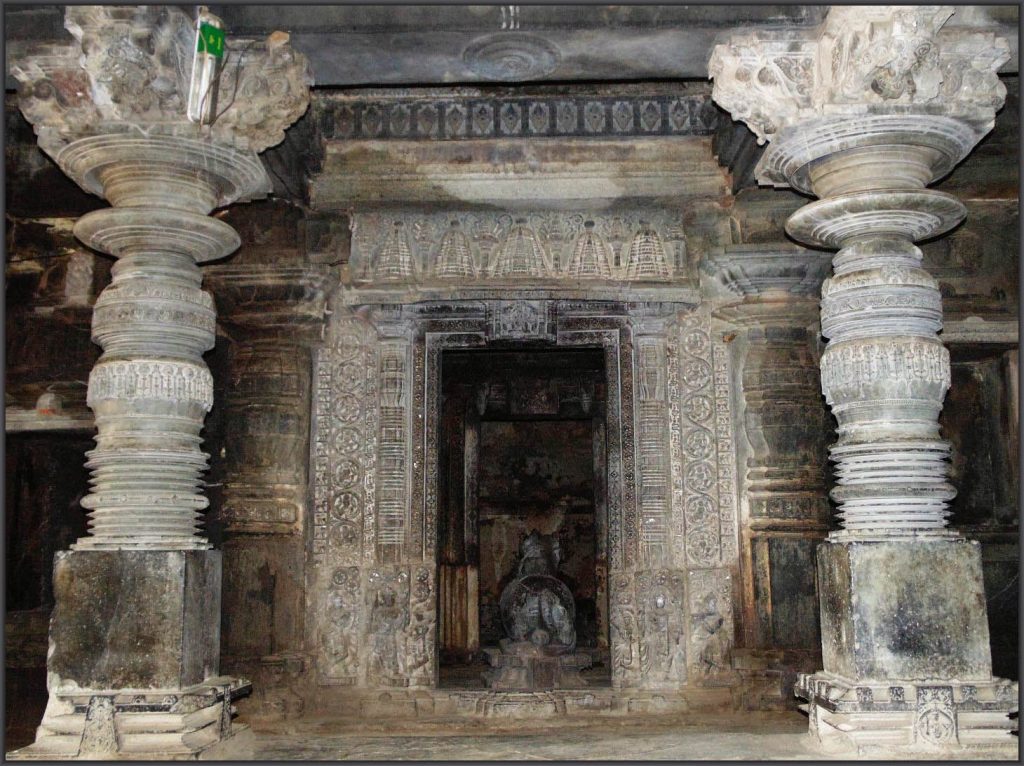 Seeing the quality of the discourse, I thought, “If we are in the business of discussing religions why don’t we also try to discuss the role Islam has had to play in the current devastation across the world.” I started the conversation by asking the other members inside the room that do they think Islam is a religion of peace? If yes, why do they think so? Do they have any evidence to prove the same?
Seeing the quality of the discourse, I thought, “If we are in the business of discussing religions why don’t we also try to discuss the role Islam has had to play in the current devastation across the world.” I started the conversation by asking the other members inside the room that do they think Islam is a religion of peace? If yes, why do they think so? Do they have any evidence to prove the same?
The Uncomfortable Reality
I ended my series of questions by clarifying my point of view by explicitly saying that according to me it was not a religion of peace and its doctrine has a huge role to play in the devastation that has been caused throughout the world. I also clarified that I do not say that all Muslims are terrorists. We need to clearly distinguish between Islamic doctrine and Muslims as a race. I was of the view that like any other idea Islam should not be beyond the realm of criticism.
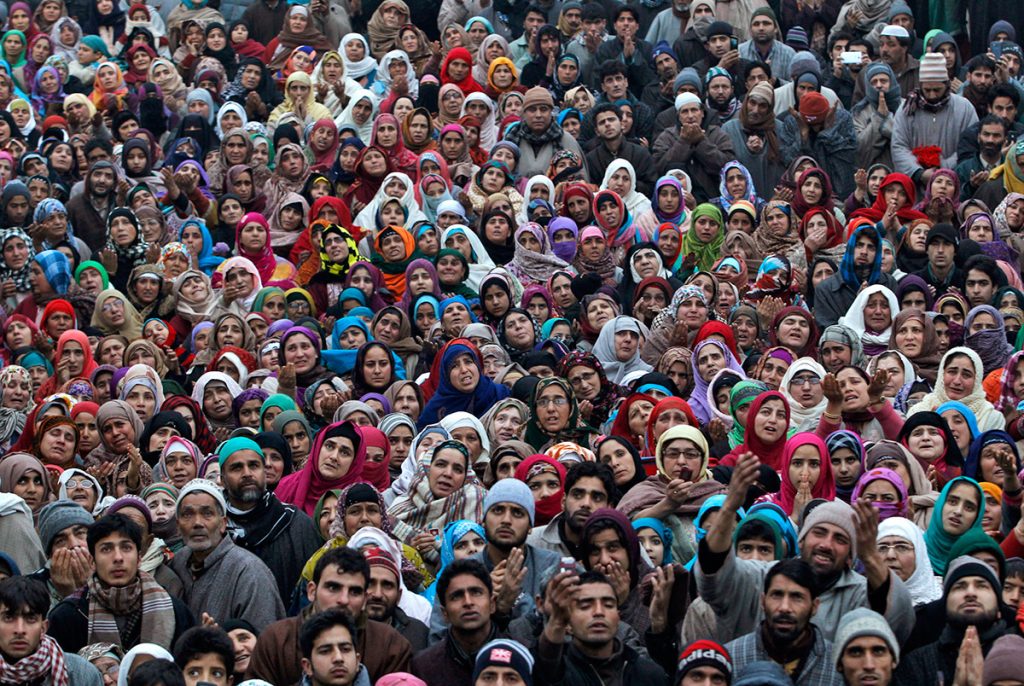 But before I could substantiate my claims by providing any form of evidence I was bombarded by a barrage of pejoratives/labels where, some of the members started calling me communal, fascist etc. What I had experienced was astonishing. The people surrounding me were not bothered by the fact that Islamic terrorism has caused so many problems globally. What they were bothered by was how dare I share this fact with them. So according to them the act of sharing the information that ISIS has caused so many deaths around the world is more problematic than the act of ISIS committing those heinous crimes.
But before I could substantiate my claims by providing any form of evidence I was bombarded by a barrage of pejoratives/labels where, some of the members started calling me communal, fascist etc. What I had experienced was astonishing. The people surrounding me were not bothered by the fact that Islamic terrorism has caused so many problems globally. What they were bothered by was how dare I share this fact with them. So according to them the act of sharing the information that ISIS has caused so many deaths around the world is more problematic than the act of ISIS committing those heinous crimes.
This discomfort and inability of the left liberals to criticise Islam is what I call ‘the soft bigotry of low expectations’. This phrase was conceptualised by US ex-President George W. Bush. The expression refers to a prejudiced attitude of intolerance with respect to races and religions, especially those which are not the main accepted ones. It implies the subtle discrimination that takes the form of setting low expectations.
 Take another example; In a recently conducted debate at the ‘Women in the World Summit’ in New York we saw another shining example of the soft bigotry of low expectations. Ayaan Hirsi Ali started her speech by saying “I embrace Muslims but I reject Islamic law because it’s totalitarian, because it’s bigoted and especially bigoted against women”. She then followed it up “When its law becomes the law of the land, you have a male guardian, child marriage…you will be disinherited and if you are raped it’s your fault, and you will get stoned to death. I reject Islamic law because it is inherently hostile to women.” She went on to say, “We will not defeat and we will not eradicate these practices unless we talk about the principle, and the principle is enshrined in the Islamic law of sharia.”
Take another example; In a recently conducted debate at the ‘Women in the World Summit’ in New York we saw another shining example of the soft bigotry of low expectations. Ayaan Hirsi Ali started her speech by saying “I embrace Muslims but I reject Islamic law because it’s totalitarian, because it’s bigoted and especially bigoted against women”. She then followed it up “When its law becomes the law of the land, you have a male guardian, child marriage…you will be disinherited and if you are raped it’s your fault, and you will get stoned to death. I reject Islamic law because it is inherently hostile to women.” She went on to say, “We will not defeat and we will not eradicate these practices unless we talk about the principle, and the principle is enshrined in the Islamic law of sharia.”
The Selective Outrage
But these comments obviously did not go down well with a popular and leading journalist of India, Barkha Dutt who was moderating the debate. She retorted back by saying “Isn’t religion inherently misogynistic? To me coming from a so-called third world country, I find it shocking that America debates abortion.” What does this say about the mindset of left liberals? They always seem willing to give Muslims a get out of jail card for free when it comes to certain standard behavioral attitudes which they would otherwise find extremely condemnable.
Just think about it. How many times have you seen ‘Left Liberals’ complaining about the Friday roadside prayers conducted by Muslims in different parts of India? But you will see them shouting and screaming about Hindu festivals creating traffic jams and causing discomfort to the average citizen. When it comes to Islam, liberals conflate ideology with individuals. A genuine criticism of Islam suddenly becomes an assault on all the Muslims worldwide.
The Psychology of the Left Liberals
This is because the left liberals views the world through the lenses of victimhood and oppression. It is these lenses that stop them from discussing the issue of Islamic Terrorism. Yes, there are good Muslims. But what has that got to do with a genuine discussion about the doctrine of Islam? If we can have an honest discussion about Hindutva, why can’t we have the same in the case of Islam? Are left liberals saying that if someone criticises Hindutva it means they hate all Hindutvavadis?
The discomfort and hesitation to criticise the doctrine of Islam come from this grossly inaccurate and improper belief in the mind of the left liberal which paints all Muslims as victims of Hindu oppression. It is because of rubbish like this that any act of terrorism committed and any doctrinal belief held in the Quran is not subjected to the level of scrutiny it deserves. It all ends up with the same old line i.e Islam is a religion of peace! ISIS has nothing to do with the doctrine of Islam.
If we were to say Indic philosophies are better than Islam in many aspects we would become a fascist. Or if someone spoke of a Uniform Civil Code in India he would have committed blasphemy. How dare he expect similar standards from other religions? This is the soft bigotry of low expectations. Why should some religions be allowed to be morally mediocre while others are expected to bear the brunt of their mediocrity?
A lost cause?
Religious tolerance does not mean we accept bad behaviour. Pluralism does not mean we start accepting bad ideas. How long are we going to let a huge subset of our country i.e Muslim women suffer under the pretext of respecting their values? What is the point of such values that can’t treat all human beings equally?
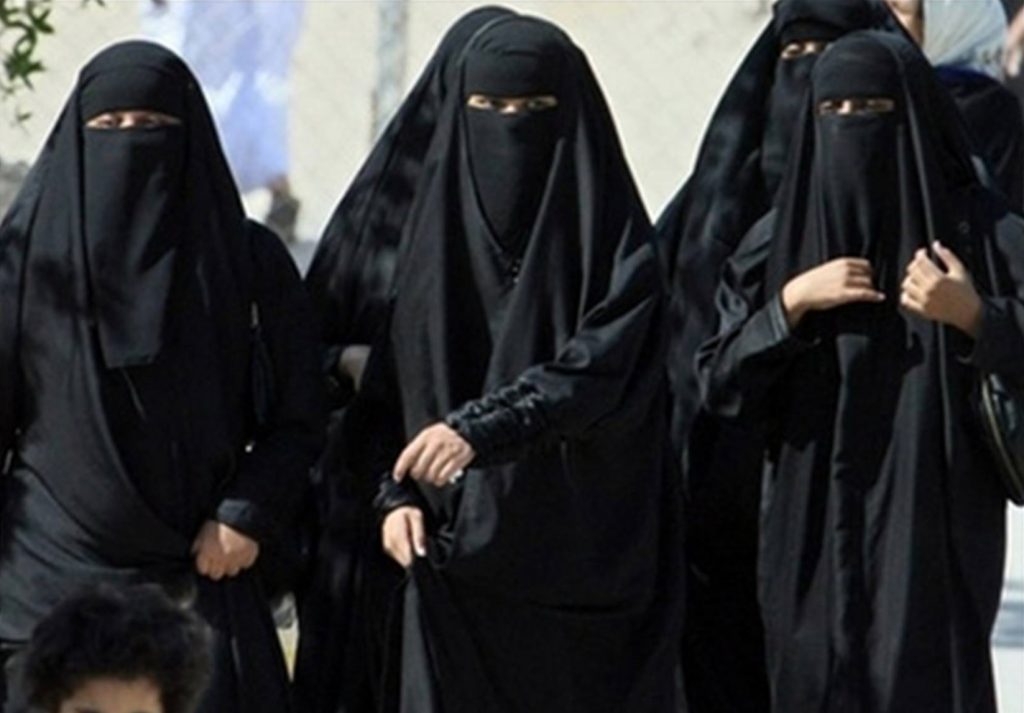
Left liberals will fight for equality of women in all other religions but Islam. They will go to the extent of blaming Hinduism for the rapes happening in India. But the moment one brings the word Islam in the discussing all hell breaks loose. It is about time someone starts to say it very openly and clearly that the teachings of Islam are incompatible with modern values and need to be upgraded. In fact, they go against everything that these Left liberals stand for. But rather than outraging over these problems you see a deafening silence. Soft bigotry indeed!!!!!
The post Left Liberals Soft Bigotry of Low Expectations appeared first on Dharma Today.
]]>The post Caste & Conversion – A 21st Century Version of Colonial Conspiracy – Part 1 appeared first on Dharma Today.
]]>A ‘Real World’ Hate Crime Scene
The hate-crime scene had been set. His co-conspirators were also prepared, having been briefed in the dark corners of the palace, having been given ample opportunity to prepare their own ammunition and choice of weapons and having been briefed on the strategy itself. They too took up their places to both help prepare the minds of the gathering and also to launch their projectiles in support of the impending assault. At a time of tranquillity, in a setting when the assault was least expected, he deployed his lethal projectile and at his signal. His co-conspirators launched their volleys in rapid succession, raining down a hail of hatred upon the wholly unsuspecting victims.
Once the weapon had been deployed and the assault completed, the settling emotional and intellectual dust revealed three casualties – every Hindu ever born (including my children) and yet to be born had been injured, the reputation of all British Hindus lay slaughtered, and the dignity and reputation of the institution itself as a seat of “evidence based debate & reasoning” had been, in the eyes of all rational observers, crucified.
The masterful assailant who executed this act of religious persecution, was Baron Lord Harries of Pentregarth, former Bishop of Oxford. The scene was the British House of Lords. The devastating weapon, a favourite of centuries of Hinduphobics and other spiritually corrosive “assassins of indigenous traditions”, was the word CASTE. “
The Anatomy of the Hate Crime
On the 5th March 2013, a debate was underway in the Upper Chamber of the British Parliament. A debate on the Governments proposals concerning Business and Enterprise. It was a dry and business like subject, one which hadn’t drawn particularly significant interest from outside of the House. But it was a debate that was well attended and was important for the Government to see successfully concluded.
Lord Harries of Pentregarth stood to participate in the debate and introduced what has since become commonly known as the “Lord Harries Caste Amendment”. In the hour that followed, in a performance worthy of the best of Shakespearean actors, Lord Harries demanded, pleaded, cajoled and implored the gathered Peers to rush to act and to protect 480,000 of her Majesty’s subjects who did not have the protection of the Law and suffered on a daily basis.
Lord Harries demanded that the word Caste be swiftly added to the list of “protected characteristics” already included in the Equality Act of 2010, i.e. Age, Disability, Gender reassignment, Marriage and civil partnership, Pregnancy and maternity, Race, Religion or belief, Sex, and Sexual orientation.
What followed was a masterful execution of “vilification and denigration by association”, co- ordinated with generous helpings of entirely unjustified indignation, self-righteousness and the unrelenting flagellation of the British Hindu community. With manipulation and orchestration worthy of Machiavelli, clothed in cloying false piety, Lord Harries skilfully and deliberately misrepresented data, which if true, branded 50% i.e. 1 in 2 of all British Hindus, as being guilty of being born prejudiced, perpetrators of discrimination on a daily basis.
The baton was eagerly taken up by Lord Inderjit Singh, who deceitfully and in a manner of betrayal reminiscent of the quintessential traitor Raja Jaichand, brought shame to both the Sikh and Hindu tradition by abandoning Satya, “Reality” in a thinly veiled act of religious persecution.
This perfidy was achieved by misrepresenting the fully humanist teachings of the oldest scriptures of humanity, the ancient Vedas. In a speech which brought shame to the memory of Guru Teg Bahadur (Tyagi Mall) revered by Hindus and Sikhs alike, Lord Singh wielded hearsay and religious prejudice itself in successfully connecting Lord Harries’ unevidenced, fabricated deluge of Hindu crimes directly with the Hindu scriptures, completely avoiding the inconvenient truth that over 90% of the cases referred to in the report being contemptuously brandished under his nose by Lord Harries, named his own Sikh brethren and their institutions as guilty of the self-same charge.
In a parade which called longingly to the glory days, when Bible brandishing Anglicans delighted in pouring contempt on Pagans and Heathens alike from their elevated pulpits, Baroness Lady Thornton, who co-sponsored the amendment, pronounced: “Studies confirm the caste system exists in the UK, with over 850,000 people affected”, not for a moment feeling the need to consult census data or evidence.



Lord Deben called to a mythical imaginary past, populated by those Anglican British saviours who had magnanimously passed legislation to protect non-whites while the former Bishop of Oxford, was that day standing as the saviour of the downtrodden brown folk of India, the so called “Dalit” community.
Lord Harries basked in the glory of being the Saviour to whom the community, whose largely converted Anglican descendants and their Anglican co-religionists, had turned in despair. With arms outstretched, they beseeched his Lordship to free them from the shackles of the notoriously discriminatory British Hindu community with its abhorrent Hindu caste system, or so everyone was led to believe.
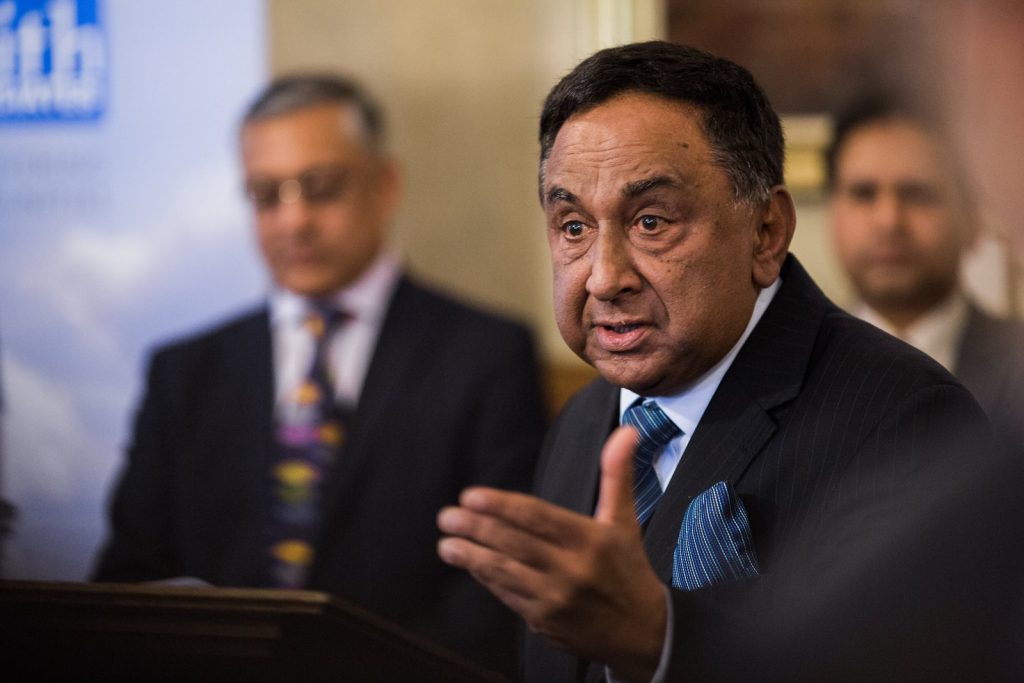
An honourable Lord of Pakistani descent, Lord Sheikh launched into a further targeted act of Hinduphobia, whilst completely overlooking his own traditions’ ongoing genocide of minority communities, a tradition which has seen Christian, Sikh and most noticeably Hindus, ethnically cleansed in multiple acts of genocide, in both Pakistan and Bangladesh, in even this decade. In the spirit of public service both Lords Deben and Baroness Flather, flamboyantly prideful in their air of Lordly infallibility and supremacy, concluded by pouring scorn and contempt upon democratically elected representatives and the religious leaders of the British Hindu Community.
The remaining Peers bathed in the joy of their most rejuvenating and nourishing pastime, shouldering Kipling’s ‘White Man’s Burden’ and saving the British Hindus, the dark skinned heathen of the 21st Century, from the ravages of their uncultured unbridled passions and prejudices.
The members of the Lower House led by Labour MP Virendra Sharma, a few weeks later regaled their audience with tales of woe and sorrow, tales which inconveniently conflicted with the grass roots experience and personal evidence of many MP’s, critically even those from the most Indian of constituencies, and which conflicted also with my own experience of having lived in this country for over 50 years.
Lord Harries’ assault reached into the very heart of my home and disrupted the tranquillity of my family and my community, it cast a cloud over my children’s future, British children born in Ascot and educated in British schools in Berkshire, and fully decent gentle members of our British community.
The Official Statistics on Hindu Community in England
As a member of the British Hindu community that with only 2% of the population, contributes 6% of GDP, has the second lowest rates of arrest, trial or imprisonment at 0.5% i.e. only 421 Hindus in prison nationally (after British Jews’ 0.3%) I was stunned to learn of this allegation against us.
According to the United Kingdom’s Office of National Statistics, of all ethnic minorities in Britain, the British Hindus had the highest rate of economic activity in 2011 whilst suffering disproportionate levels of institutional prejudice and discrimination. Scholars state that the Hindu community in the United Kingdom, and Europe in general, has consistently faced discrimination in immigration policies adopted by the local governments.
In local councils, construction or expansion permits for Hindu temples and community centres have been turned down for years, while Muslim mosques and Christian churches have been approved by the same councils and built.
Nearly 50% of Hindu children, both boys and girls, in British schools have reported to being victims of bullying for being Hindu and their religious heritage.
To emphasize the level of discrimination, the recent much publicised Hate Crime policy, focussed entirely upon the Muslim and Christian communities on all the 40+ pages, with no mention of discrimination to the Hindu, Sikh and other non-abrahamic traditions a single time!
All of this and yet, with NO reliable evidence, no social impact analysis, no public consultation and no genuine participation from the targeted minority community – how was it possible that such a Hindu phobic amendment had found its way to the floor of the House of Lords?
The impact of this legislation, the unrestrained hatred towards and denigration of my minority religious community and also the torrent of pain being expressed by so called “Dalits”, all caused me to stop, dumbfounded in my tracks. A detailed review of the process which climaxed that day in the Lords, uncovered even more deeply troubling and wholly unexpected revelations.
In today’s sadly not so Great Britain, a Britain where in 2016
- a Labour Prime Minister, Tony Blair, has been condemned in the strongest of terms for initiating an illegal war, amidst calls for him to be tried as a War Criminal,
- where a Chief Constable is on record as declaring that there are probably in excess of 750,000 paedophiles inflicting incalculable harm upon vulnerable citizens at this very moment,
- where the latest report reveals that in excess of 50% of all girls are sexually harassed in schools,
- where surveys have indicated that 1 in 3 of the indigenous British population are racist,
- where we are now on the 4th attempt to conduct an Enquiry into the INSTITUTIONALISED sexual abuse of vulnerable adults and the wholesale grooming of Hindu, Sikh and White young girls spanning a period of 30 years,
- where the Church of England is on record as admitting that it has repeatedly failed to protect vulnerable children entrusted to their care,
- where the Archbishop of Canterbury has accepted that sexual abuse, Bullying, Sexism and Racism are rife and are systemic problems in the ‘by law established’ Church of England,
- where Parliament has been rocked by a succession of scandals concerning abuse and bullying…
How on Earth was it possible, in the midst of all of these devastating social and religious challenges, with so much work for decent Parliamentarians to deal with, that the British Hindu community would be been singled out for such generous attention and be targeted for such an insidious corrosive assault?
The Labour Party, the traditional darling of all British Indians, was approached but in response, they deployed the ultimate ‘weapon of mass compliance’ (traditionally very sparingly used as a coercion of last resort, used only to force MP’s to toe the party line despite their own assessments). The draconian 3 line Parliamentary Whip itself was summoned to ensure that this legislation was passed, carried on a wave of indignant self-righteousness, without detailed Labour party scrutiny nor consultation with its Hindu community representatives, and yet there was no reliable evidence to support the dire need nor the desperate urgency, merely Lord Harries’ masterful manipulation of the Parliamentary process.

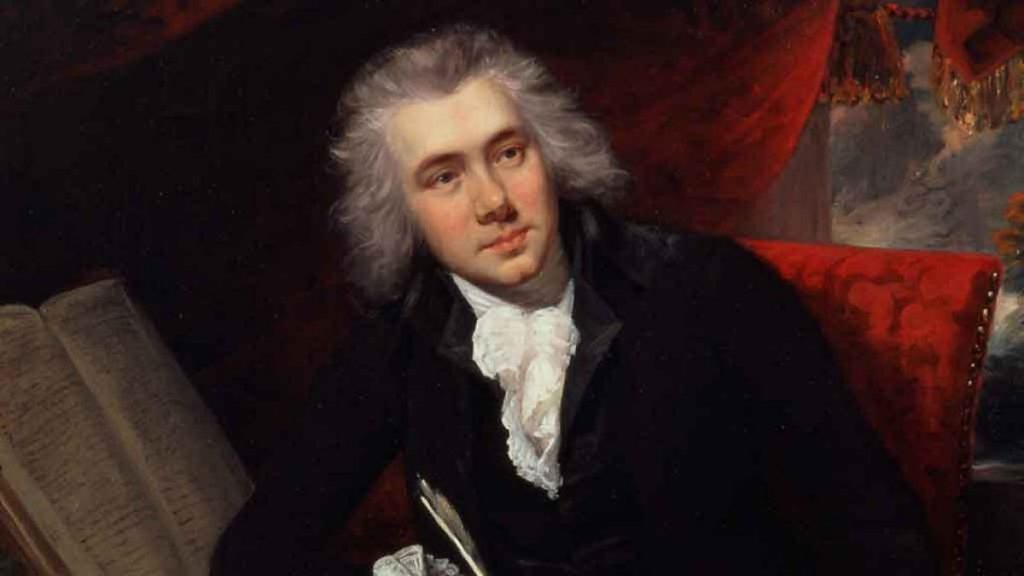 The famous Anglican fundamentalist Wilberforce, in 1813 addressed the Commons saying “Our religion is sublime, pure and beneficent, theirs (the Hindus) is mean, licentious and cruel.” Whilst James Canning standing tall on the Anglicans belief in their own superiority, told a gathering of Hindus, “You are all a parcel of poor ignorant semi barbarians, you do not even understand your own language and system as well as we enlightened Englishmen who have been at regular Grammar schools…” All whilst Bishop Heber was crafting a hymn chanting “The heathen in his blindness, bows down to wood and stone…can we whose souls are lighted with wisdom from on high, can we to men benighted, the lamp of life deny”? Judging from the words of Lord Deben, one has to ask whether the ‘racist orientation of old’ of the House of Lords, with its assumed superiority over even grass roots community organizations, is still alive and well, thriving and active covertly if not overtly. Has so little changed in the Upper chamber in over 200 years?
The famous Anglican fundamentalist Wilberforce, in 1813 addressed the Commons saying “Our religion is sublime, pure and beneficent, theirs (the Hindus) is mean, licentious and cruel.” Whilst James Canning standing tall on the Anglicans belief in their own superiority, told a gathering of Hindus, “You are all a parcel of poor ignorant semi barbarians, you do not even understand your own language and system as well as we enlightened Englishmen who have been at regular Grammar schools…” All whilst Bishop Heber was crafting a hymn chanting “The heathen in his blindness, bows down to wood and stone…can we whose souls are lighted with wisdom from on high, can we to men benighted, the lamp of life deny”? Judging from the words of Lord Deben, one has to ask whether the ‘racist orientation of old’ of the House of Lords, with its assumed superiority over even grass roots community organizations, is still alive and well, thriving and active covertly if not overtly. Has so little changed in the Upper chamber in over 200 years?
Who Created the Modern Version Caste System and How
I wondered about the consequences to Interfaith when it became common knowledge, that the Caste system which Lord Harries was railing about, was itself an official creation and imposition of white Anglican Colonialist missionaries. There were indeed then, as now a very small minority of decent men, who abhorred their own creation seeing its destructive effect, whilst continuing to impose it.
The Lords did not refer to the annotation made by the white Anglican ML Middleton “We pigeon holed everyone by caste and if we could not find a true caste for them, labelled them with the name of hereditary occupation. We deplore the caste system and its effect on social and economic problems, but we are largely responsible for the system we deplore. ML Middleton, ICS, Superintendent of the Government of India, in the Census 1911 Report for Punjab and Delhi (Vol. 15, Part I, p. 343).”
Lord Harries, graced with the mantle of academic rigour associated with a Dean of Kings College, moulded in scholarship by Selwyn College Cambridge, and a Gresham Professor of Divinity, can be expected to know what most informed Hindus know, that amongst the educated Hindus it is accepted that the Anglican plunderers, known romantically as “Colonialists”, created the modern day caste system in India. In doing so in India, the social engineers of the Anglican Church were recreating the horrific power structures which they, as the religious and moral force in Victorian Britain, had also created in Britain and successfully inflicted upon the British population in the 18th and 19th centuries.
And here in the 21st century, an Anglican Bishop was once again, blackening whole swathes of a minority British community, using the same philosophy, only this time he was bringing home one of Colonialist Britain’s most successful exports, the concept and ideology of Caste.
“The British colonial administration supported and sustained, she argues, the caste system because it echoed the subtle and deeply entrenched social hierarchy already prevalent among the British themselves. Subsequently, the colonial state deliberately raised the caste consciousness of the sepoys of the Bengal army, encouraging Brahmins among them to regard themselves as elite and to become more particular about the preparation and eating of their food. Doniger has noted that the notions of caste, which in India had traditionally been relatively fluid and secondary, became rigid because the sepoys were made to understand the caste as being central to their notions of self identity and respect. Subsequently, the idea that the caste is the basis of the Indian social order and that to be a Hindu is to be a member of a caste became a dominant colonial axiom (Doniger 2009).
The answer to the question “Who created the Caste system?” is that the Anglican Jihadis of the British Raj created the Caste system. The Church of England is both responsible for its existence and to be held accountable. Are they also responsible for manufacturing the concepts of untouchables, dalits, etc?
The post Caste & Conversion – A 21st Century Version of Colonial Conspiracy – Part 1 appeared first on Dharma Today.
]]>The post Jati as a Practical Economic Model, Not an Oppressive One – Dialogue between Rajiv Malhotra and R Vaidyanathan appeared first on Dharma Today.
]]>Professor R Vaidyanathan: You brought up this interesting issue of the Jati system. I’ve always maintained two or three important things in this.
First thing is, when we talk about Jati, it doesn’t mean we talk about Caste discrimination. These two are totally different things. People immediately jump and then, second is I think you’ve been writing also you know quite well that this whole idea Caste is taken for Portuguese language, prior to this we were not having it. It was not hierarchical, it was made hierarchical with the British in order to suit their own idea of how India should be viewed because they have this in the Government service in Britain, the A, B, C, D classification, so which is one. If I recall correctly, in 1881, the first to Census, brought in this whole idea of Caste enumeration and hierarchically bringing it. If my numbers are right, some 1300 and odd castes were listed at that time. In 1881, first Census of India, prior to this there was no regular census.
Rajiv: But Jati was different.
Prof: But they…
Rajiv: …they turned in to castes. So how is Jati economics?
Prof: So that’s what they did and you know that very interesting, In 1881 census, there were quite a number, nearly 100 plus were one-member castes. Only one member claimed under. And then they decided, Based upon their own idea, how to make it hierarchical. Till then there was no idea of hierarchical because there is a huge churning that is always taking place. What we consider today as so called lower-groupings in the communities, they became in the higher-grouping in the communities and vice versa. If you for instance, talk to lower-grouping they will never recognize themselves as lower-castes. They will say we were Kings.
Rajiv: But still I am trying to get what is the economic purpose of the Jati?
Prof: Actually what has happened is we have an uncanny ability to deride anything on which we can leverage. If you look at, I use the word caste itself, significant amount of economic progress in various clusters, there are some 870-900 defined clusters of economic activity in the country. Not Bombay, Delhi type of thing, there is Tirupur, there is Sivkashi, there is Morbi, there is Punjab. So like that various places. All of these clusters are thriving economic activity and boom centre and almost all of them are caste based structures.
Rajiv: Not the upper castes?
Prof: No! Not at all.
Rajiv: Okay! That’s important.
Prof: Including the schedule castes. I have seen in Agra and other places. It facilitates in several ways. One is, risk mitigation for instance.
Rajiv: Ok, so now we have started the real point. First benefit of caste is risk mitigation.
Prof: If suppose somebody fails, other don’t look down upon him as a failure or anything. They go and help him.
Rajiv: Do they support each other?
Prof: Yes. They support each other.
Rajiv: So it is an economic club.
Prof: Yes. Credit is made available without much security or paperwork because they know that there is a caste pressure on him to repay. It’s more a question of honour, not rule. It is more relationship based. We are a relationship based society, not rule based society. Relationship based society has got ideas of concern about fear of God, more than fear of love. The urban people in India, the middle class and merchant banking groups, they don’t have a fear of God.
Rajiv: So is it like a chamber of commerce?
Prof: Sort of. You can call it.
Rajiv: There is a chamber of commerce of people who are in one industry or another industry.
Prof: Yeah, I accept this chamber of commerce what we loosely call, ‘suited-booted-tied’ people. These people don’t have any of those type of things. They are mostly dhoti-clad, pan chewing and they do not even speak English.
Rajiv: But what is the secret to that they say we’ll be a club, we are all fisherman or we are all growing the same thing, we are not competing against each other, so what is the secret to cooperation not competition.
Prof: Secret to cooperation is because their view of the world in terms of business is, the opportunities are so large. So there’s no need for cut throat competition. The other thing is also very interesting, that is an opportunity to take over the activities of another caste person from the same location in Tirupur. I was talking to him why he did not grab it? He said no sir that is not normally done.
Rajiv: So they will not do hostile takeover? They will not try to wipeout the competitor.
Prof: No. He says it’s not required.
Rajiv: It’s not within the honour?
Prof: It’s not within the honour. It’s much larger opportunities and other thing. They don’t operate on ‘greed is good’. No! They don’t operate on that. They accumulate wealth and then they share it. Very important. Many of them have told me, the greatest of character of Mahabharata is Karna. Not Arjuna, not Krishna. For the simple reason, he shared. So, that is what we should do. Our life is short. I think we have to understand this whole groups’ approach toward the business and activity is totally different.
So, risk mitigation, credit, market access – these are the benefits of Jati.
This system also encourages youngsters. For instance, the Patel’s who started the Motels in the western coast of US. Practically, they have captured the entire motel business. They have encouraged large number of people of their own community.
Rajiv: Yeah. If you are a Patel, they’ll set you up. They’ll get you a motel. You are in business.
Prof: Correct. Or you go to this Antwerp, a small group of people, Jains actually, they are called Malankar Jains, they are a very small group but they have captured the diamond business in Antwerp. As a closely knit When I was visiting Brussels, some hotel had this Jain food counters. So I was puzzled. Why Jain food? Vegetarian food is okay but Jain food. Since the customer base is like that. To an extent, Wall Street Journal wrote an interesting article because the Jews had 70 percent of the diamond business in around 1970’s-1980’s. Today, these people(Jains) have 75 percent of the business. So, Wall Street Journal wrote a very interesting article, first time, the Jews have been defeated without violence. That’s the most important part of the story. Again they have operated as a very small cluster or a group. Very important is Caste is a good cluster to leverage on it.
The post Jati as a Practical Economic Model, Not an Oppressive One – Dialogue between Rajiv Malhotra and R Vaidyanathan appeared first on Dharma Today.
]]>The post Inculturation and How it is Subverting Hindu Practices in India appeared first on Dharma Today.
]]>Let’s consider the patent scenario between two religions. What if religion A adopts the appearance and practices of religion B with the ill intention of deceiving the people of religion B? What if those practices are deliberate means to convert unsuspecting and ignorant folks of religion B into religion A? One religion can blatantly copy and appropriate characteristics of other without any repercussion. Regrettably between religions, there is no preventive mechanism or laws to discourage such malpractices. And this is what happening in India today. Certain Christian evangelists are unethically and superficially copying many of the practices of Sanatan Dharma to facilitate conversion.
These are not simply isolated events. This is a well established and articulated policy adopted by various branches of Christianity and by the Roman Catholic Church called inculturation where Church teachings are adapted and changed to make them more palatable to non-Christian cultures. The precise definition of this term as listed at Vatican site is following:
The process of inculturation may be defined as the Church’s efforts to make the message of Christ penetrate a given sociocultural milieu, calling on the latter to grow according to all its particular values, as long as these are compatible with the Gospel. The term inculturation includes the notion of growth, of the mutual enrichment of persons and groups, rendered possible by the encounter of the Gospel with a social milieu. ‘Inculturation [is]the incarnation of the Gospel in native cultures and also the introduction of these cultures into the life of the Church.’
Further Vatican site also describes specific efforts required on the part of evangelists to achieve inculturation:
The inculturation of the Gospel in eye modern societies will demand a methodical effort of concerted research and action. This effort will assure on the part of those responsible for evangelization: (1) an attitude of openness and a critical; (2) the capacity to perceive the spiritual expectations and human aspirations of the new cultures; (3) the aptitude for cultural analysis, having in mind an effective encounter with the modern world.
If the purpose of inculturation is not avidly clear from the above references, then following statement from John Paul II describes its purpose without leaving any confusion:
The Church must make itself all things for all men, bringing today’s cultures together with sympathy. There still are milieus and mentalities, as there are entire countries and regions, to evangelize, which supposes a long and courageous process of inculturation so that the Gospel may penetrate the soul of living cultures, respond to their highest expectations and make them grow in the dimension of Christian faith, hope and charity. Sometimes cultures have only been touched superficially and in any case, to continuously transform themselves, they demand a renewed approach. In addition, new areas of culture appear, with diverse objectives, methods and languages.
Herein the Vatican is quite explicit in that the ultimate purpose of the inculturation process is to bring non-Christians who are residing in other cultures into the Christian fold. There are many such inculturation practices adopted by missionaries in India.
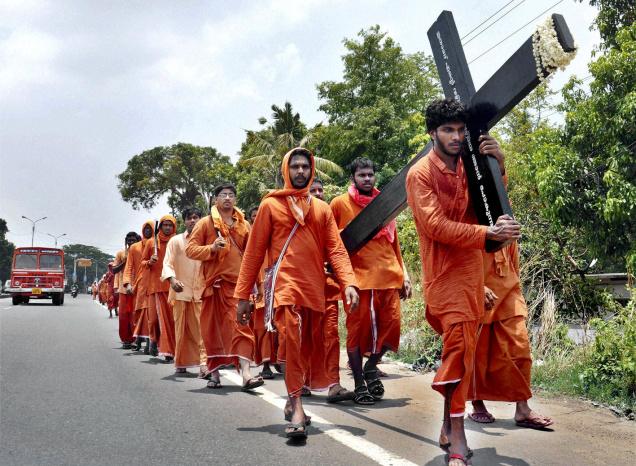 Christian missionaries in Hindu saint dress
Christian missionaries in Hindu saint dress
- Christian Evangelists masquerading as Brahmins, Purohits or Sanyasis adopt Hindu names while wearing saffron outfits.
- The Christ presented as a yogi is combined with an entire range of missionary subterfuges.
- Missionaries sing bhajans to Jesus instead of Hindu deities like Rama, Krishna or Shiva by substituting their names with Jesus.
- Idols of Jesus and Mary are placed side by side with murtis of Hindu deities.
- A Christian form of Bharat Natyam has been invented leveraging traditional Hindu dance forms as offerings to Jesus.
- Hindu pillars or stambhas are placed in front of churches in South India to look like Hindu temples.
- Churches perform arati to Jesus rather than performing the usual Christian rituals.
- Churches describe their crowd gathering event as satsang which is a Hindu term.
- Mother Mary is made to resemble Hindu Goddesses in her depictions.
- Yoga and meditation techniques are copied and presented in desankritized Christian forms.
- Deliberately misquoting, mistranslating and misinterpreting Hindu scriptures and puranas in an attempt to prove that Jesus was both an avatar of and a Hindu God.


Infant Lord Ganesha with Mary and Jesus depicted in form of Lord Vishnu
One may wonder why evangelists need to operate using such fraud and deceptive practices in the first place. The answer is simple. If Hindus were aware of their true practices and beliefs beforehand, then they would not entertain their hidden conversion efforts. Hence evangelists temporarily shield Christian practices and beliefs from Hindus until the missionaries are convinced that the unsuspecting conversion targets are ready to accept Jesus as their ‘only savior’.
It is critical to understand the ethicality of such practices by missionaries from the lens of Christianity itself. For example, Christianity largely opposes idolatry and even considered such ‘pagan’ practices as a ‘radical sin’. But during the process of inculturation, no such tenets are adhered to by evangelists. Does this mean that idolatry is now acceptable by followers of Christ the world over? Christian authorities will certainly not permit this for their flock as these manipulative practices are intended only for luring the unsuspecting locals.
Furthermore, there are major issues with the use of native Hindu practices by missionaries in the first place. This usage constitutes nothing less than appropriation and, in many cases, fraud and cheating.
Finally, there is the issue of the subversion of original practices of Hinduism. Many of these practices lose their inherent meaning and value when they are distorted. For instance, the chanting of bhajans without Sanskrit words do not produce the same effect as they do in their original form.
Rajiv Malhotra, prominent Hindu intellectual, elaborates on the long-term impact of the inculturation process on native cultures:
By assuming the mantle of the originators and bearers of universal truths – both sacred and secular – the West has often embarked on and justified programs, missions and schemes to bring the rest of mankind around to its own worldview. I use the metaphors of “tiger” and “deer” to illustrate the process of what I call the “digestion” of one culture by another, carried out under the guise of a desire to assimilate, reduce differences and assert sameness. The key point being made is that the digested culture disappears. This digestion is analogous to the food consumed by a host, in that what is useful gets reformulated into the host’s body, while that which doesn’t quite fit the host’s structure is eliminated as waste.
The post Inculturation and How it is Subverting Hindu Practices in India appeared first on Dharma Today.
]]>The post The Need to Rewrite Indian History appeared first on Dharma Today.
]]>Quite predictably, leftists in India raised a cry of tampering with history, as if history is a fixed science that cannot be adjusted. The fact is that history books in India still largely teach the British view of India from the colonial era and have not changed much since the independence of the country over fifty years ago. The only exception is history books in Marxist states like Bengal that have been rewritten in a communist slant, which is even more against the traditions of the country than the British view.
History books are always being rewritten and they should be, as new information comes in and our understanding of culture widens. This does not mean that history should carelessly be rewritten to suit an ideology, as in communist Russia or in Nazi Germany, but that we must not turn old accounts of history into an unalterable dogma. History is not a material science like physics that deals with hard facts and even physics textbooks are continually being updated. The West has often tried to give its version of history the finality of science, but political changes since the end of the colonial era have revealed the biases behind its accounts, particularly of Africa and Asia. The western account of history cannot be given the finality of the physical sciences and should be expected to change radically over time.
Colonial Distortions of History East and West
Up to two decades ago, the history of America was taught as the wanton aggression of the Native Americans, the so-called Red Indians, on the gentle white settlers who simply wanted to farm and raise their families in a wide land that had room for many people. This was the predominant view of Christians and of educated Europeans in America. The real history was one of the genocide of native peoples and their cultures in a greed for land and power. The so-called savages honored all treaties. The so-called civilized white man didn’t honor any.
The European history of Africa followed similar prejudices, with the native blacks as uncivilized barbarians that had to be civilized by the white Europeans. That the blacks did have venerable and rich old cultures and were really the target of exploitation and genocide was covered over. The same phenomenon occurred throughout the colonial world, including Asia, where native peoples were subjugated and their cultures denigrated. Like the blacks, some Asians were turned into slaves or serfs, uprooted from their land and taken to foreign countries and commercially exploited. This was also done in the name of civilizational advancement through Christianity and European culture. That is how over a million Indians ended up in the Caribbean in Trinidad and Guyana.
The European treatment of India was the same as that of America and Africa, starting with the Portuguese in the sixteenth century, who brought the cruel ways of the Inquisition to India. The Indian mutiny of 1857 occurred because the British brought in aggressive and intolerant missionaries and had the country in the grip of a cruel economic exploitation. Yet such oppression has been left out of the history of India as told by the Europeans and independent India has not rewritten the record adequately. Similarly, the destruction wrought during the Islamic period, which was worse than the British period in terms of religious and economic exploitation as well as genocide, has been similarly ignored or downplayed so as not to offend minority communities.
 Yet can one seriously imagine given all the colonial distortions of history worldwide which are only slowly being removed today that no real revision of the history of India needs to be made? Can we believe that somehow by luck, in spite of their prejudices, that colonial and European scholars got the history of India right and wrote it without any distortion or bias in their favor, though they failed everywhere else?
Yet can one seriously imagine given all the colonial distortions of history worldwide which are only slowly being removed today that no real revision of the history of India needs to be made? Can we believe that somehow by luck, in spite of their prejudices, that colonial and European scholars got the history of India right and wrote it without any distortion or bias in their favor, though they failed everywhere else?
Liberals and leftists in America sympathize with the native cultures of Africa and America and their need not only for correcting historical accounts but also for restoration for historical wrongs. But, strangely, leftists in India still vaunt the colonial view that India was uncivilized before the British and denigrate their own native traditions!
When ancient historical finds are made in China, as with the uncovering of the tomb of the first emperor dating to the third century BCE, there is great national pride even among the communists. But all the massive finds of the Harappan/Sarasvati culture, as well as the retracing of the once great Sarasvati River, bring no pride to many intellectuals of India. They would ignore these, dismiss them as an invention of Hindu communalists, or imagine that they represent an unknown civilization that vanished mysteriously with no real connection to the later traditions of the region! Though the Vedic literature is the largest of the ancient world by all accounts, Indian leftists will have no pride in it and seek to denigrate it as best they can. Though the Mahabharata at over two thousand years old is the world’s oldest and longest national epic, Indian leftists don’t even want it taught in the schools (even when the common people find great pride in watching the Mahabharata on television).
In this regard, we should remember that Marxism and communism in India are largely anti-national movements. Marxists in India sided with China against India during the Indo-Chinese war of 1962 and raised no criticism of China for its attack. They sided with the British during the independence movement. This is a stark contrast to communism in Russia, China and Vietnam in which were part of larger nationalistic movements. This is because Indian Marxists came mainly from a British Marxist background and did not participate in anti-colonial struggles, as did the followers of Mao and Ho-chi-minh. They were largely intellectuals from wealthy families, educated in England, not workers in the field, much less freedom fighters.

The distortion of history has been done intentionally by many modern Indian historians, particularly covering over historical wrongs against Hindus. They believe that by correcting history that the present can be changed. They pretend that the generally cruel Muslim rule in India was benign and secular so that this account will serve to make modern Hindus and Muslims more benign and secular and help them bury the past. But the opposite is true. If a nation does not face its true history, it has no future and its present remains confused. This would be like American historians pretending that Native Americans (Red Indians) were treated well through history and that accounts of their oppression and genocide were false or exaggerated, so as to bring harmony to the two communities today. This would only allow old prejudices to continue.
India has not faced its past in order not to offend certain minorities in the country who may still harbor anti-nationalist sentiments. It has also been intentionally done in order to prevent the majority community from awakening to its colonial and religious oppression, fearing this would increase communal disharmony, even though distortions caused by this, like the image of Hindus as barbaric idolaters, continue in the world media today. The result is that the country lacks a genuine national pride and a sense of its continuity to ancient times.
History and Nationalism
One of the main purposes of history books, as taught in different countries in the world, is to instill a sense of national pride and honor in short to inculcate a sense of patriotism and nationalism. Whether it is the United States, Great Britain, Russia, Germany or China, this is certainly the case today and has been so as long as these countries have existed as modern nations. The lives of great leaders, particularly the founders of the country are highlighted, the continuity of the nation’s history is emphasized, and the importance of the nation in the history of the world and the greatness of the national culture are stressed. Students are expected to come away from reading accounts of their history with a sense of national greatness and purpose, not only for the past but also for the future.
However, India is a strange and unique country in which history books are often anti-national in nature. India has largely kept in tact the British approach to Indian history devised in the colonial era. Students of such textbooks come away apologetic or confused about their country and its traditions. Textbooks in Marxist ruled states of India like Bengal and Kerala leave their students with a sense of the greatness of communism and communist countries like China or even Russia which is no longer communist, rather than any real regard for India and its great traditions.
History books in India try to ignore the dominant Hindu ethos of the country and its history before the Islamic period. India’s greatest historical and cultural document, the Mahabharata, is hardly given any attention in the schools. So too, the Vedas, Ramayana, Puranas, Buddhist Jatakas and other prime historical and cultural documents of the country are ignored because of their religious overtones. If they do address India as a nation, it is only India of the independence movement that they acknowledge, as if prior to 1947 India did not really exist. While Nehru is made important, older kings from the Rig Vedic Bharatas to Yudishthira of the Mahabharata period to the Marathas of the eighteenth century are hardly mentioned. There is no real sense of any historical continuity to the culture, much less to the country. While Mahatma Gandhi is emphasized, the greater spiritual traditions of India and its great teachers from the Vedic rishis, Vedantic, Buddhist and Jain sages to modern savants like Sri Aurobindo and Ramana Maharshi is not given much attention.

It is true that history should not be a mere instrument of a destructive nationalism and should avoid instilling aggression against other lands and peoples, even when upholding what is valuable in a nation’s history. But this does not require that the national value of historical studies is negated altogether.
The question, therefore, is how the history accounts in India can be made to reflect and instill a genuine nationalism and sense of the country’s history and destiny. India, after all, is one of the great civilizations of the world, with cultural traditions that have much value for humanity. Such historical accounts must reflect the richness and diversity of Indic civilization, but they cannot ignore its unity and continuity either.
Building a Nation
The fact is that you cannot build a nation without creating history books that instill a positive nationalism, particularly in the youth. The real danger in India is lack of national spirit and historical consciousness that keeps people alienated from their roots and the country divided.
A true Indian nationalism will be rooted in an Indian ethos of dharma, spirituality and pluralism, but this does not mean there can be no national or historical pride without encouraging communalism in the country. On the contrary, a greater sense of national identity would be the best thing to counter the disintegrating influence of religious, castist and regional interests that are bringing the country down.
Therefore we must ask: Why can’t Indians connect India’s traditional ancient literature, the Vedas, with its archaeology through Harappa and the many Sarasvati river sites? Why can’t Indians find national pride in their own history both on literary and archaeological levels? Why should history in India be used for national shame, rather than national pride? Why should the history of India place Indic civilization out of India? These are questions that must be answered.
Western and Indic Views of History
The subject of history in the western context is a very different than in the Indian context. In the western view, history is mainly an account of political events and economic progress, a purely outward affair. In the Hindu view, history is a means of teaching detachment, showing how great kings and kingdoms come and go in the course of time. It has an inner value as a spiritual teaching about the nature of human life and the need for liberation from worldly concerns. In the western view, history is progressive from the crude beginnings of agriculture and village life moving forward to the present day urban culture. In the Hindu view, history is cyclical, with various cultures coming and going over time as the soul seeks liberation from the phenomenal world.
The western progressive account of history is quite flawed. For example, the first civilizations of the ancient world that we can document including Egypt, Sumeria, India and China did not regard themselves as the first but were aware of many cultures and kingdoms before them, particularly prior to a great flood. The civilizations that we regard as the first saw themselves as very old with many antecedents! Yet we pretend that there was nothing before them! In addition, the civilizations of the Third Millennium BCE, like those of Egypt and Harappan/Sarasvati India, had better urban and architectural achievements than those that followed for many centuries. Even Europe had its Dark Ages after the Roman period in which much knowledge was lost. This idea of history as linear progress is clearly not the case. While humanity has progressed scientifically, this is mainly over the past five hundred years. On the other hand, we see a spiritual decline since ancient times, and over the last century we can note a decline in culture, art, music and philosophy in Europe itself, coinciding or even caused by great advances in science.
As India is the only civilization of antiquity to survive the onslaught of time, it is the special responsibility of Indians to discover not only their history but also that of the entire ancient world. Just as there are unquestioned distortions of ancient India, similar distortions of other ancient cultures also exist. For example, the religion of ancient Egypt, which like that of the Vedas demonstrates much occult and spiritual significance, is similarly dismissed as polytheism, idolatry or henotheism (worshipping different Gods as the supreme God), exactly like the Vedas. Revamping the way history is taught in Indian schools would be a major step in the direction of a more authentic and spiritual sensitive history of the world. It is a scientific and spiritual imperative, not only for India but for all countries.
(Chapter from book Hinduism and the Clash of Civilizations)
The post The Need to Rewrite Indian History appeared first on Dharma Today.
]]>The post Krishna Janmasthami – Birth of a Lover or an Exterminator or a Statesman appeared first on Dharma Today.
]]>Krishna as an intimate lover
In the Vedic literatures, there is no clear mention of the number of gopis that were in love with Krishna. It ranges from hundreds-thousands-millions to a billion. Primary of them are eight, called as the principal gopis with whom He exchanged incomparable degrees of love and affection.
Merely just by a sense of figures, it is impossible to imitate such a scale of relationships. And qualitatively it is almost impossible to exchange such emotions for even one person throughout our lives, which history has proved time and again.
Krishna as a social reformer
Krishna married 16,108 wives. However, none of these marriages were a peaceful, engagement-wedding-reception-celebration affair. They were all politically significant at that time. All of the marriages represent a political victory along with an ability to take personal responsibility. Of them, these 16,100 princesses rescued from the custody of demon Narakasur would have nowhere to go and with a social stigma on them they would only invite further exploitation. But by marrying them, He gave each one a respectful identity and a status in the society. Indeed, each one of them had a palace for themselves with personal reciprocation with Him! By giving personal shelter to discomforted princesses, He became a great social reformer.
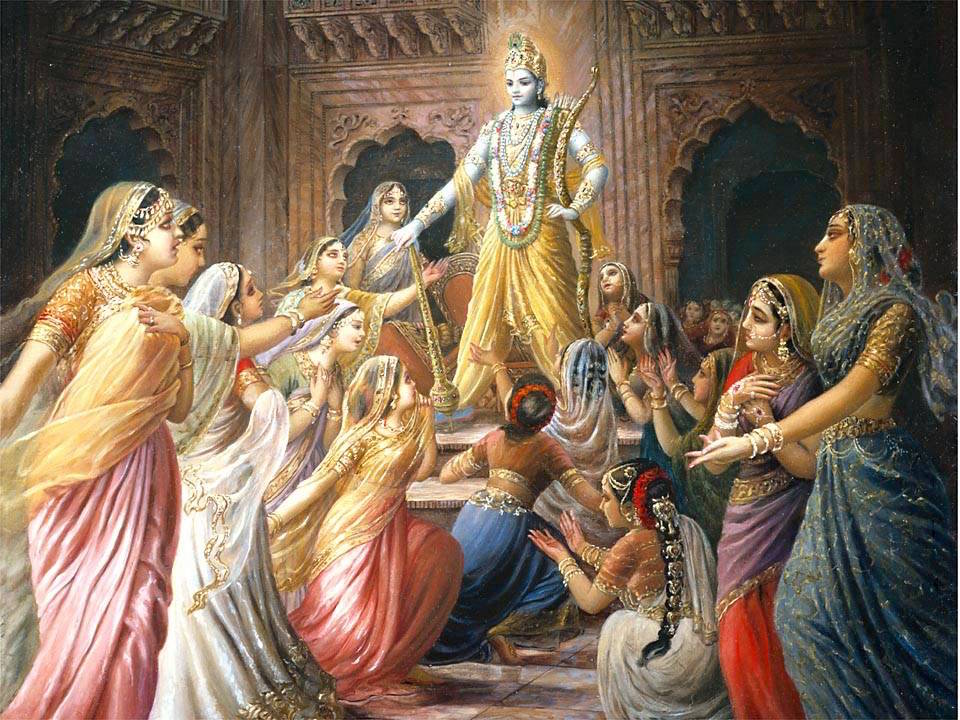
Krishna, the Exterminator
The best median estimates of deaths for various conflicts throughout the recorded history put the death toll at 487.7 million people. This is certainly not an accurate figure due to innumerable reasons, but it does give some idea to the scale of violence. These wars were conducted over many weeks, months and years and spread over 14 centuries. Compare this with the eighteen-day Mahabharat war conducted at the behest of Shri Krishna.
In the Mahabharat Book 11 (Stri Parva), Chapter 26, Verses 9 &10 the number of casualties in the war is given. “One billion 660 million and 20,000 men have fallen in this battle. Of the heroes that have survived, the number is 240,165.” This eye-popping figure is approximately 4 times the earlier statistics that too in a mere eighteen days!
When the modern scholars try to see this aspect of violence only statistically, ignoring the whole context and rationale behind the war, it overwhelms the mind. Who would care if you loved a trillion but could eliminate a billion in just no time!
Krishna as the Statesman
Yet another popular argument is “Do not mix religion and politics”. Many times people try to separate God and spirituality from country and politics. This sentimental de-linking is akin to disconnecting Krishna from Kurukshetra altogether and only confining him to the groves of Vrindavan. The Kurukshetra war was not simply fought because it was affecting his loving exchanges in the forests of Vrindavan. It had broader principles of establishing righteousness (dharma samsthapana) for common people so that it would facilitate their overall Dharmic growth – pusushartha (Performance of obligatory duties) and paramartha (Pursuing the Absolute Truth).
The argument would sound better if the statement was, “Do not politicize religion”. It is not God or spirituality that is an obstruction to a Nation or vice-versa. Any Nation is built upon an ideology. An ideology of Dharma is what Krishna wants to establish, hence the war on territory. Ideology is like the food and Nation is the plate on which it is served. Nationality and spirituality with its associated religious practices cannot be separated. After all, all the scriptural wars or the teachings that have been spoken by various Avatars and Devatas, are connected to a territory- broadly referred in vedic literatures as desh-rashtra (country), prant-khand (territory), kshetra (place), nagari (town) and so on.
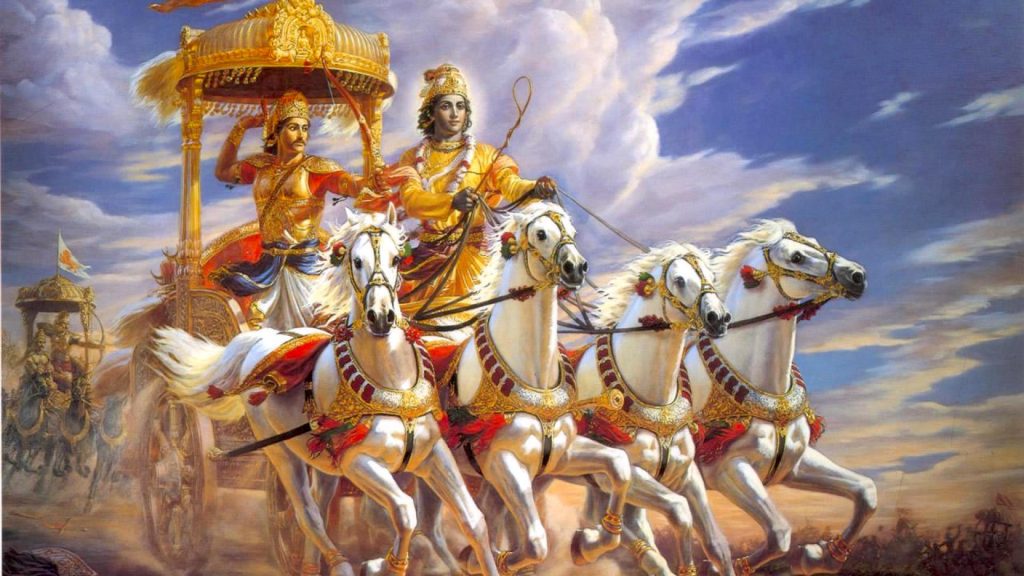
Nationalism in the context of Sanatan Dharma is not something limited to fixated boundaries. The protection and preservation of the places that inspire and facilitate one’s righteousness is an integral part of ones sadhana (spiritual practice) and duties. It was Arjuna who did not want to fight for a piece of land and it is Krishna who made him reclaim the territory, not for the sake of it, but for establishing Dharma even at the cost of one’s Guru or loved relatives.
As a finest Statesman, He taught Arjun to not only look at the gross deceptions of Dhritarashtra, Duryodhan, Karna and others, but also to the subtle deceptions caused by Bhishma and Drona. Bhishma and Drona represent ‘seniors worthy of worship’ (Bhagavad Gita 2.4) and authoritative figures. Yet they fail to give adhikaar (rights) to the deserving and empowerment to the able and un-willingly they display pseudo-philosophy. Arjuna was enslaved and weakened by the affection of grandfather Bhishma and the position of Guru Drona. However, Dharma cannot be obliged simply to the sentiments of love or to the sentiment of ‘worshippable seniors’ who fail to discharge their obligatory duties (which is why He chastised Arjun). Certainly not when there is a serious disorder in righteous principles (which is why there was a WAR). Dharma would not glide down to such an extent but for the silence of Bhishma and Drona.
Krishna made every effort to avoid a war. After all He is not a warmonger. Yet, to prevent a war at the cost of Dharma is not acceptable. Establishing Dharma is not always a comfortable talk or about gaining academic qualification. It simply means to live up to the Truth, the Absolute Truth!
As one of the controversial but notable figures of modern times wrote, “Therefore I say it is really difficult to understand Krishna. It is very easy to understand a pacifist, because he has clearly chosen one side of the coin of truth. It is also easy to understand warmongers like Genghis, Tamburlaine, Hitler and Mussolini, because they believe in war as the only way of life. Pacifists like Gandhi and Russell believe that peace alone is the right way. Both doves and hawks are simplistic in their approach to life and living. Krishna is altogether different from both of them, and that is what makes him so difficult to understand.
Modern historians try to analyze Krishna, weighing different parts of His personality against the other. Some even try to debate the existence of Krishna despite the overwhelming archaeological evidence. Yet I would argue, it is not so important how and where Krishna did what, as compared to whether He is relevant or not today.
The principles laid down by Him are timeless – NOT confined to any particular time. In them one can see the fundamentals of reality and truth described one after the other. Just like a scientific theory has something known as constants (a constant is called so because it is very fundamental, very basic, and cannot be ignored at all), Krishna’s teachings are also a constant. He is not religious in his approach but purely logical, scientific and socially relevant. That makes Him, not only an element of the past but also of the present. He will remain therefore the future of civilization through His constant eternal principles.
It would be a great injustice to measure Krishna from a singular dimension of His life. That would be another form of deception – a pseudo-philosophy. Krishna represents everything from a personality of individual care, love and affection to a strategist in war to the finest of all Statesmen. He represents everything that is called life!
The post Krishna Janmasthami – Birth of a Lover or an Exterminator or a Statesman appeared first on Dharma Today.
]]>The post Pollock’s obsession with Sanskrit’s past instead of what it really says appeared first on Dharma Today.
]]>The most expedient way, in a time of limited technology, to absorb entire lots of people into the dominant societies’ civilizational fishnet was by hostile takeover – war. The invaded and defeated people were then relatively, quickly assimilated, into the ways and norms of the invaders. Religions, commerce, social standards and cultural ethos were all unceremoniously uprooted and discarded, until only tattered ghosts of the past were left to haunt the captured generations with the life that was. From Genghis Khan to Alexander the Great, history is replete with examples of civilizational hijacking.
Mind Games
However, as technology advanced and globalization took center stage, nations realized that the options on the table for domination had expanded. War was not the necessary or even preferred means to capture the minds of the ‘other’ masses. Through modern statecraft, mass media and global accessibility to citizens of the world, one nation or region could hold another hostage economically, socially and/ or culturally, without any overt military gestures. Appropriate to the Information Age, a new kurukshetra or a battlefield has emerged where the front is the mind and our cultural identity the prize.
One of the most sought after prizes over the last fifteen hundred years has been the Indian civilization. In almost every category of value, India has had something to offer its people and the world at large. Over the last three centuries, the latest incarnation of appropriation of Indian cultural has been led by the Western intelligentsia.
Indologists Rising
As far back as Sir William Jones of the eighteenth century, Indologists have played a complex game of praising and admonishing the traditions of dharma. No true intellectual can honestly ignore the broad range of profound metaphysical and existential truths that permeate the intellectual, social and personal arenas of the dharma-based societies. Yet these philosophies and their embodied manifestations were categorically different enough from the religions and philosophies of the West that the dharma traditions were equally targets of ridicule, appropriation, misinterpretation and even destruction.
Dharmic intellectuals like Sri Aurobindo, Swami Vivekananda and Sita Ram Goel identified and outlined this destructive journey of the Western elites and worked to stand up for their cultural identity.
As a poignant example, in his Indian Spirituality and Life, Sri Aurobindo exclaims:
Here is the first baffling difficulty over which the European mind stumbles; for it finds itself unable to make out what Hindu religion is…How can there be a religion which has no rigid dogmas demanding belief on pain of eternal damnation, no theological postulates, even no fixed theology, no credo distinguishing it from antagonistic or rival religions? How can there be a religion which has no papal head, no governing ecclesiastic body, no church, chapel or congregational system, no binding religious form of any kind obligatory on all its adherents, no one administration and discipline? For the Hindu priests are mere ceremonial officiants without any ecclesiastical authority or disciplinary powers and the Pundits are mere interpreters of the Shastra, not the lawgivers of the religion or its rulers. How again can Hinduism be called a religion when it admits all beliefs, allowing even a kind of high-reaching atheism and agnosticism and permits all possible spiritual experiences, all kinds of religious adventures?
A Not So Intelligent Fixation
The Battle for Sanskrit, the latest book by Hindu intellectual and cultural strategist Rajiv Malhotra, has immersed many Hindus into the crosshairs of Western thinkers. Many leading Western academics have interpreted the dharmic knowledge systems with lens’ outside the confines and frameworks of the dharmic traditions themselves. By such interpretation governments, institutions and the masses have been categorically misinformed about the very nature of dharma and its manifestation in India and beyond.
Sheldon Pollock, the primary target of intellectual critique in Malhotra’s book, is considered by many as the leading Sanskrit scholar and Indologist of our times. Upon further exploration of Sheldon Pollock’s perspectives, a particular video (http://video.scroll.in/804595/watch-sheldon-pollock-answering-his-own-question-what-is-indian-knowledge-good-for) was unearthed, where he was speaking to Indians in Mumbai, India in 2014. Some of his views struck a nerve.
In his talk and in line with many of his Indologist ancestors, there were several assertions by Pollock, albeit craftily made, that run counter to the ethos of Sanskrit and sanskriti – dharmic living.
We do not study ancient Indian past to find the cure for cancer in a Vedic text. There is no cure for cancer in a Vedic text, there’s no recipe for cold fusion in the Veda. Knowing something about the past is radically non-instrumental if I can put it that way.
Sanskrit As It Is
Sanskrit grammar is condensed into the minimal amount of words as possible for a reason. The codified language, where a single word can have innumerable meanings, keeps the door open for innovation in understanding and application.
For instance, the Sanskrit word atma can mean the self, one’s body, one’s mind, one’s spiritual identity, a sense of one’s identity, all of the above at the same time or some combination of the above. When placed in a Sanskrit phrase, the context will help one to unravel its intended meaning. But the most authoritative translators who are spiritually mature and in tune with standards of interpretation have the clearest purview into unlocking the secret behind every word.
All this means that Sanskrit is designed to withstand shifts in time and culture. While context helps, it is not bound to context as a vast array of Sanskrit terms, especially those found in sastra (spiritual texts of dharma), have built in meta meanings that may have more relevance in one era than another. Therefore, claiming that Sanskrit is a relic of the past with no relevance to the present and especially the future is to belittle its intrinsic truth.
The Realms of Consciousness
Krishna says in the Bhagavad Gita that individuals and societies succumb to the lower realms of consciousness as and when they cannot unearth the eternal and divine aspects of things. Their perception of the world is thus filtered by this consciousness. But the higher your consciousness rises the more you are able to perceive the very filters themselves and ultimately see beyond them. This state cannot be achieved through empirical means alone as it requires commitment to the spiritual practices embedded in the very traditions one is seeking to understand.
This is explained repeatedly throughout the Upanishads and Puranas yet routinely ignored by secular enthusiasts and academics. The reason is they have to ignore it (and systematically so) in order to preserve the ‘integrity’ of their historical consciousness. Historical consciousness refers to the sequencing and piecing together of tangible and intangible evidence of the Western and Abrahamic systems of thought and faith. It gives rise to endless dogmas and an impulse to destroy all elements of their own or others’ cultures that would sabotage this way of living and thinking. Hence, for them, denying Sanskrit’s inherent and independent sacredness is a categorical imperative.
Don’t Look Back
Finally, the Western discomfort with the past is something to be deeply analyzed. For the West, the past is something to be overcome and generally associated with our less evolved states of being.
There is no better evidence of this than the West’s obsession with progress. While there is no denying that progress is something to be coveted for us all, there is an assumption in the collective Western consciousness that all things not new are less good than those that are. This may be partially true for areas like technology but sets a scary stage when applied to social affairs, politics and personal development.
Infinity and Beyond
Such thinking, a byproduct of a historical consciousness that anchors itself to the realm of the finite, is dangerously limiting. The Abrahamic traditions, of which the most notable Western Indologists ascribe to, especially commit to a fixed point in time and space where the genesis of all creation including their own existence has come to be. How then can such thinkers be handed the keys to the matters of the infinite?
Superimposing this paradigm onto the traditions of Dharma relegates Sanskrit and sanskriti, by association, to an entirely secular experience riddled with worldly motives, as Pollock exclaims, and not something that descends from and is imbued with divinity. Not something that represents the experience of hundreds of millions in the past, in the present and the centuries to come.
The post Pollock’s obsession with Sanskrit’s past instead of what it really says appeared first on Dharma Today.
]]>